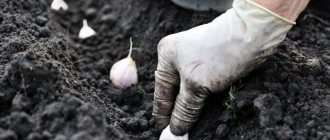In the garden plot, potatoes, cucumbers and tomatoes are often grown. And about vitamin vegetables, such as eggplant, are forgotten or are afraid of difficulties in care.
The culture has a wide range of vitamins, minerals and macronutrients that are beneficial to health. In order for all this to be in the composition of the fruit, it is worth paying attention to the rules of watering, feeding. And also learn how to plant eggplant seeds for seedlings.
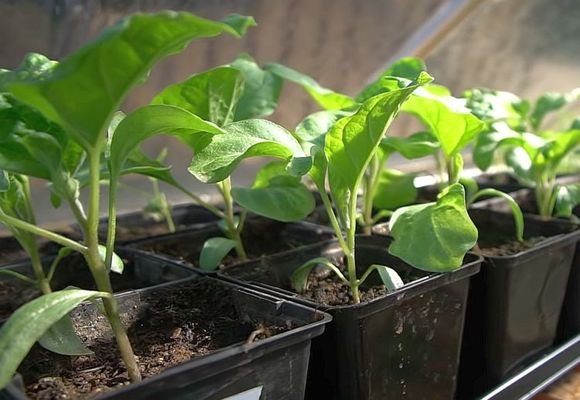
Growing eggplants in different regions
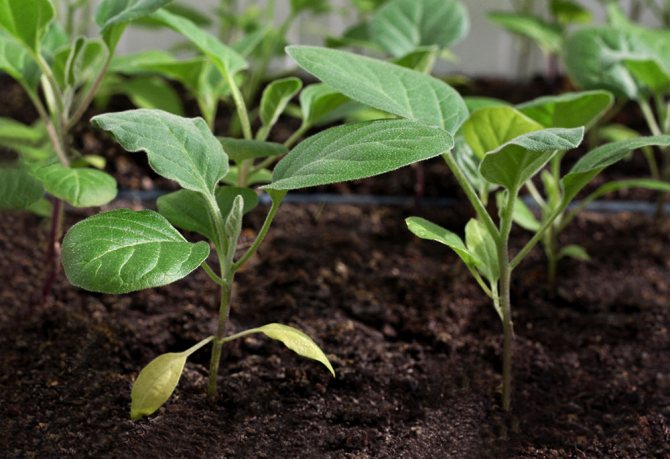

Eggplants, or as they are popularly called "blue" refers to nightshade crops that prefer a well-fertilized soil, temperatures between 15 and 25 degrees and sufficient light. The vegetable is most often grown in greenhouse structures. Depending on the climatic conditions, the greenhouse should be equipped with additional heating devices in case of unexpected frosts.
In the south, the vegetable can be grown outdoors, but with preliminary planting of seedlings in greenhouse conditions. In the middle lane and northern regions, nightshade should be grown only in indoor structures. Before planting seeds in the ground, it is necessary to choose favorable days for planting eggplants, focusing on the lunar sowing calendar.
The timing of planting eggplant seedlings depends on the selected variety, its early maturity, the quality of seed preparation, and growing conditions. Favorable days for sowing should be chosen taking into account the positive influence of the lunar phase and the zodiacal constellations. The moon, when passing around our planet, has a huge impact on all natural processes. The success of vegetable growing depends on whether you choose a good period when to sow seedlings or not.
Before deciding when to plant eggplants for seedlings, familiarize yourself with the important conditions for effectively growing blue ones. To ensure you get a good harvest and not waste your efforts, consider the following guidelines:
- for sowing eggplant for seedlings, choose a suitable variety that you can grow in your region, taking into account the ripening time and temperature regime;
- use only high-quality seed with an optimal shelf life for incorporation into the soil. The maximum shelf life of seeds is 7 years. It is better to use seeds that are no more than 5 years old;
- prepare fertile soil for seedlings;
- choose favorable days for planting eggplants according to the lunar calendar;
- plan regular maintenance of the seedlings.
In most regions, climatic conditions do not allow sowing eggplants for seedlings any day. A whimsical culture needs careful and regular care, so it is worthwhile to play it safe and involve the natural help of the Moon in your own work.
Preparing and sowing seeds for seedlings
And since eggplant is a rather capricious culture, let's take a closer look at all the stages of cooking and sowing seeds.
First you need to select seed.
How to choose seed for eggplant seedlings?
- Choose seeds depending on the area in which you are going to grow the vegetable. So the seeds must be zoned. After choosing a variety for a certain climatic zone, you predict a good harvest.
- It is best to use hybrids.Such seed is characterized by accelerated germination, and can also withstand diseases and pests.
- Consider the packaging date and expiration date. Seeds with an expired shelf life are best thrown away, since the seedlings are unlikely to be successful.
- If you choose a seed material pelleted, granulated, glazed, inlaid, then such seeds do not need to be prepared for sowing. It is enough to plant and water them.
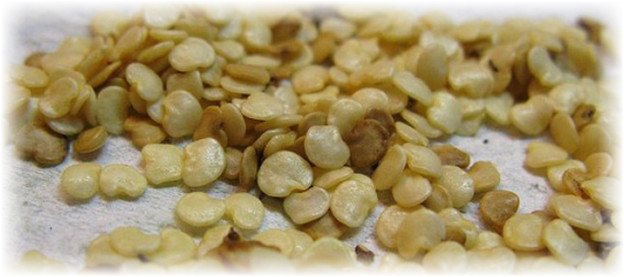

Of course, most gardeners and gardeners use their seeds, so they require special processing.
Seed calibration
Eggplant seeds are relatively medium in size and are fairly uniform by eye. But the calibration still needs to be carried out, having selected all the same seeds of the same size, since if they are planted in one container, then they will give amicable shoots and will develop well, and not drown out each other.
Do not throw away small seeds, they can also be sown.
It's just that seeds of different sizes are always sown in three different containers. But if you come across seeds that are deformed, or painted in a different color, with spots, then it is better to get rid of them.
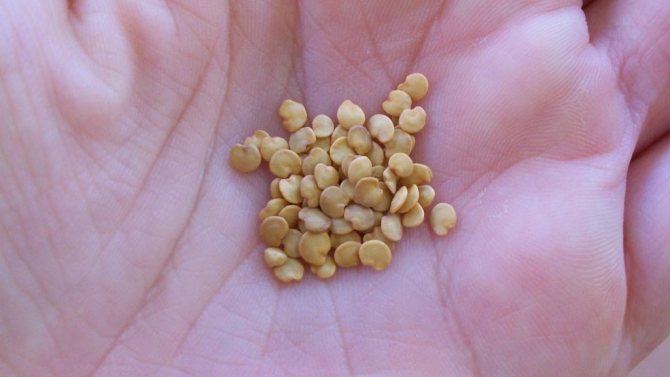

Checking the suitability of the seed
If you have read my previous articles about tomatoes and peppers, then you already know how to test seeds for validity. We work in the same way with eggplants.
So after calibrating, soak the seeds in 3% saline. Take 1 tsp for one glass. with a slide, stir well so that there is no sediment, and then lower the seeds. Those seeds that floated up are empty, which means they are not suitable. Rinse the rest with water and dry.
If all the seeds have surfaced, do not rush to throw them away. This happens if the storage conditions have not been met. So germinate this stuff first.
Germination
You can skip this method for eggplants, since the "blue" ones are not tightly similar seeds, but germination can be used for large sizes of seed material.
If you wish, you can germinate all the seeds. So, place the selected seeds on cheesecloth and place in a flat container, for example, in a tray and moisten abundantly with water. The seeds should be inside the gauze, and make sure that the fabric does not dry out. The germination temperature should be high, but not higher than 45 degrees.
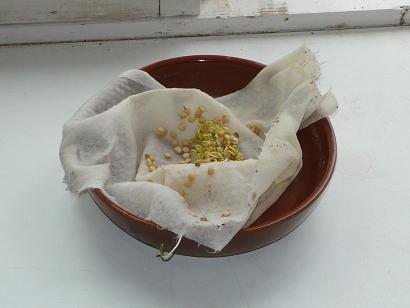

Disinfection
This step is necessary if the seeds are not processed from the manufacturer and do not have a special shell.
The most traditional and popular method of seed disinfection is soaking in potassium permanganate. The solution should be 1% and fairly deep, but not dark purple. Eggplant seeds dipped in such a liquid should be no more than 20 minutes.


By the way, if the soil into which you will sow the seeds is disinfected, then the seeds themselves do not need to be disinfected.
Seed stimulation
This step is optional and optional, but promotes the accumulation of nutrients for better seed germination. In this case, no harm is done to the plants. But the benefit is great.
I will list what stimulants and growth regulators are:
- Heteroauxin
- Kornevin
- Zircon
- Epin
There are two ways to treat plants with stimulants. So, if the drug is in powder, then the roots, bulbs and cuttings are dipped in water and then in powder. The seeds are sprinkled with powder. Or you can prepare a solution (from tablets or from powder) and immerse the plants, seeds in it for the time indicated in the instructions.


Hardening
This step must be performed if you are going to grow eggplants in open ground or if you are going to sow seeds when it is still cold.
To harden, place the seeds in cheesecloth and moisten, then keep in the cold for two days. The most optimal temperature is 0 degrees.
If you grow seedlings at home, then the seedlings themselves will need to be hardened immediately before planting in the holes in the open ground.
Most gardeners do not advise growing eggplants by sowing in open ground, since our summer is not very long, and the vegetables simply do not have time to fully ripen. It is best to grow seedlings in an apartment and then transplant them into greenhouses.
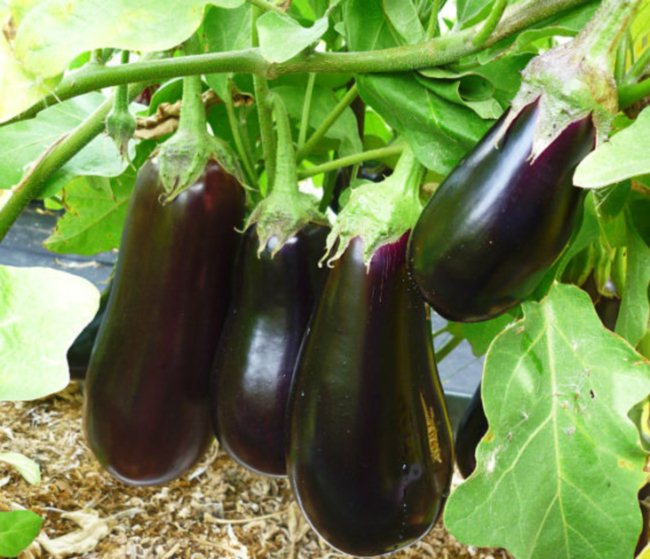

Eggplant seed germination
The germination time of eggplant seeds depends on many factors. The period between the emergence of the shoots and the transfer of an adult seedling to the greenhouse takes on average 75 days. It is important to choose the right variety so that the vegetable has time to ripen in your climatic zone.
After you have sown eggplants for seedlings in 2019 according to the lunar calendar, expect 5-7 days to peck growths from the ground. Eggplant seeds sprout at different times, depending on:
- the quality of the material for crops;
- temperature regime of soil and environment;
- soil moisture;
- seeding depth;
- fertility of the land;
- the degree of readiness of the seed.
To increase the germination of blue ones, you need to prepare the seeds for planting. This procedure is necessary in order to activate the own biological resources of the inoculum by saturating the cells with moisture.
Important! Eggplant seeds have an average germination period of 10 to 14 days. If the sprouts have not hatched after 2 weeks, do not wait for the result.
The seed sprouts 5-7 days later without preparation. Pay attention to quality pre-sowing activities. This will increase not only the germination of the seed, but also make the seedlings more hardened, resistant to diseases, more adaptable to transplantation and new conditions.
Possible problems
Improper care or the slightest deviation from the recommendations leads to problems. And then the question arises: What to do and why an unpleasant situation has arisen?
Slowness leads to the aggravation and destruction of seedlings not only for eggplants, but also for other crops. Let's take a look at common problems with eggplant seedlings.
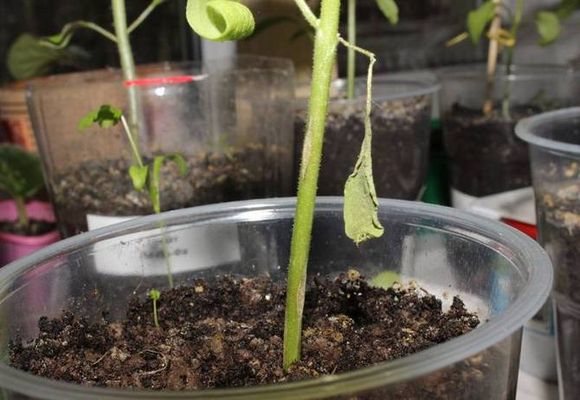

Seedlings wither
Often, eggplant seedlings disappear and wither due to damage to the root system during a pick or transplant. If the seedlings are in a peat pot or tablet, we can talk about the need for treatment for fungal diseases.
Blackleg
A disease called black leg looks especially recognizable. Decay begins at the point of contact between the soil and the stem. Outwardly, it looks like blackening.
The reason is excessive watering.
Hypothermia of the root system
Failure to comply with the temperature is the first culprit in the growth of eggplant seedlings. You can correct the situation if you adjust and monitor the temperature regime, lighting. If no shoots appear, the thermometer should also be checked.
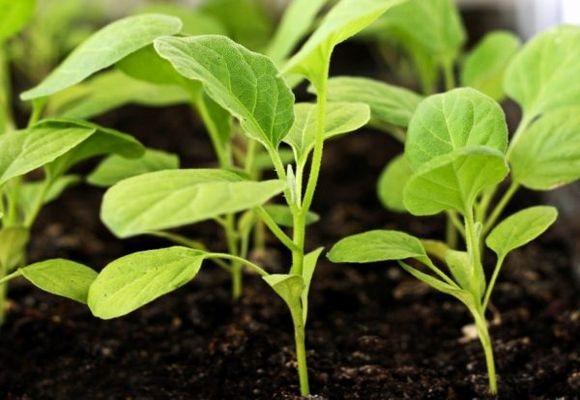

Seedling leaves turn yellow
When the leaves are dry or turn yellow, it's time to check how much the soil has been moistened. Frequent watering harms the root system, slowly kills the seedlings. Lack of nitrogen, incorrect picking also leads to yellowing of the green part of eggplants.
Yellow spots on the leaves
Provided that the lower leaves dry, it's time to feed the seedlings. Complex feeding will help to correct the situation.
Leaves curl
Variants when eggplant leaves curl indicate the appearance of pests.
It is necessary to immediately disinfect not only diseased plants, but also all seedlings. Preparations are selected from the type and name of the insect.
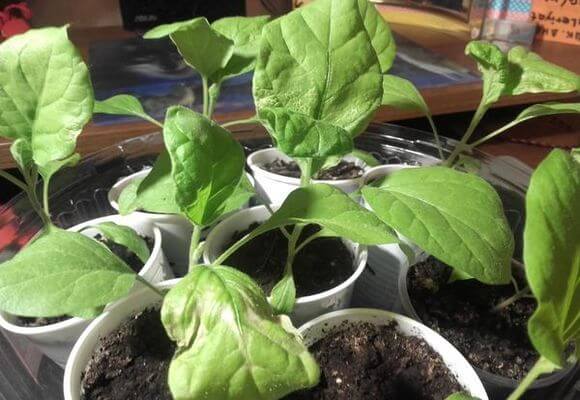

Seedlings stretched out
If the seedlings are stretched, then there may be several reasons:
- a small amount of light;
- seedlings sit densely;
- the air temperature is not adjusted.
The same reasons lead to the fact that the eggplant seedlings fall. The leaves fall down or grow sharply when the farmer waters too much.
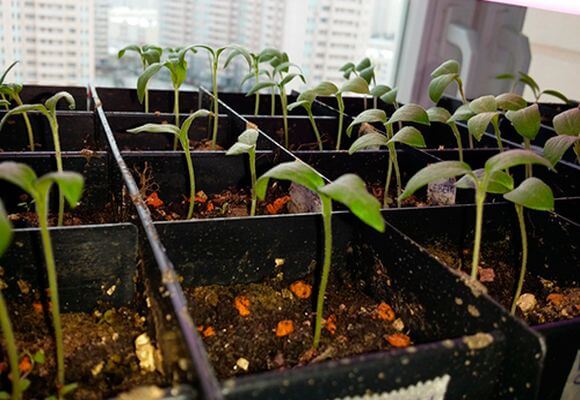

Features of growing eggplant depending on the climate
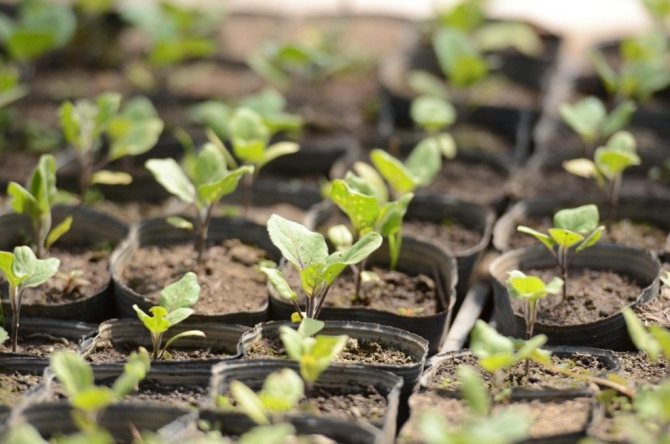

Summer residents of all regions prefer to grow blue ones in their plots with the obligatory preliminary planting of seedlings at home. Experienced gardeners plant eggplants for seedlings according to the lunar calendar in 2019. They rely on this system, since it takes into account the favorable fusion of the zodiacal constellations and lunar movement.
It is necessary to choose the right variety that will have time to give ripe vegetables before the end of the summer season. Agronomists have bred a variety of hybrids that ripen at different times:
- early ripening - the crop will be ready for harvesting 90 days after the seeds are embedded in the ground. Suitable for all areas. Gardeners of the northern regions should choose these varieties so that the plant has time to mature in greenhouse conditions;
- mid-season - after planting eggplants for seedlings according to the lunar calendar, ripe vegetables can be harvested after 120 days. Suitable for growing in the middle lane and southern regions;
- late-ripening - between sowing planting material in the ground and harvesting fruits at least 150 days. Hybrids are sown in the south, as the climatic conditions there allow the vegetable to fully ripen.
Analyze the average duration of sustained warm weather in your area. For Moscow, the Moscow region, the Leningrad region with a warm period from May to September, it is better to sow mid-ripening or early-ripening varieties. In the south, it is possible to sow seeds of different germination and ripening periods. Gardeners of the Krasnodar Territory, the Republic of Crimea, and the southern regions embed several species in the ground in the spring in order to get ripe fruits during the season. Northerners are advised to sow early maturing eggplant due to the short summer.
Suitable varieties
There are more than a dozen types or varieties of eggplants. Classification begins by type of rearing (early maturing, late and medium). At the same time, gardeners give preference to certain varieties, regardless of the ripening rate:
| Variety | View | Features of the |
| Simferopol 12/105 | Early ripe | Received by breeders in the Crimea. The creators set a goal: high yield, improved taste. The experience ended with a lasting result |
| Negus | Early | High-yielding variety. The mass of one fruit is not less than 250-300 g |
| Sancho Panza | Mid-season | A distinctive feature of eggplants is the weight of the fruit: 600-1000 g. The size corresponds to the weight |
| Vakula | Mid-season | Gives high yield rates. There are practically no thorns on the bushes, which makes it easy to collect |
| Joker | Early ripe | Carpal type of fruiting. On one brush from 5 pieces of eggplant. Fruit weight from 400 g |
You can check the quality of the purchased material by soaking the seeds in a weak manganese solution. In this case, the water must be necessarily warm. After 15 minutes, the unusable seeds float up. Must be recycled.
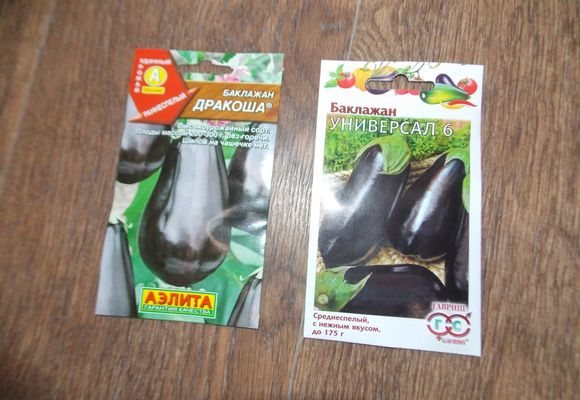

Recommended varieties
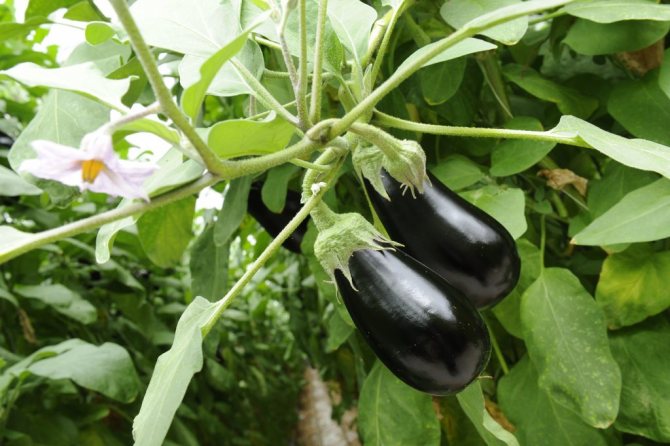

Experienced plant breeders try to sow different varieties, which agronomists breed specifically for certain climatic zones. Observations over many years and analysis of the yield allowed us to mark the most successful hybrids that can be effectively grown in different areas.
| Regions | Variety names | Characteristic |
| Northern (European North, Ural, Siberia) | King of the North Clorinda (Dutch hybrid) | Hybrids that yield on average within 90-100 days after pecking seeds. The varieties are specially bred by domestic and foreign agricultural technicians for cool zones and can be sown in any area. The plant can be grown both in greenhouses with regular ventilation and in beds. In indoor structures, moisture must be monitored so that vegetables are not susceptible to disease. When growing outdoors, analyze the climate in your area. It is possible to remove at least 10-15 kg of ripe fruits with excellent taste from each square of crops. |
| Middle lane (Moscow, St. Petersburg, Moscow, Leningrad regions, etc.) | Diamond Black handsome Marzipan | Varieties that ripen within 125-150 days. The fruits are fleshy and juicy with a diameter of at least 6-8 cm. From each square meter you can collect 8-12 kg of ripe vegetables with a dark brown color. Hybrids are resistant to most diseases and pest attacks. Transplants and fungicide treatments are well tolerated. Plants are resistant to drought conditions. Can be planted in greenhouses and garden beds. |
| Southern regions (Crimea, Krasnodar region, Belgorod region, etc.) | Diamond Marzipan | Hybrids with different ripening periods. In the south, to obtain eggplants with excellent taste, it is preferable to sow mid- and late-ripening varieties. Thanks to the long warm period, vegetables will have time to ripen and yield at least 7-10 kg from each square of crops. Cultures adapt well to new conditions after transplantation and are undemanding to care. |
It is necessary to plant eggplant seedlings on favorable days according to the planting lunar calendar, taking into account the peculiarities of the climate in the sowing region. Sow seeds embedded in fertile soil one at a time. Do not make continuous crops, as the seedlings do not tolerate picking and transfer to a new growing area.
Before transplanting eggplant seedlings, analyze long-term observations when frosts recede and the temperature of the ground in greenhouse structures at night does not cool more than 15 degrees.
Top dressing
Thanks to feeding, plants grow and develop much better. You can feed with the following types of fertilizers:
- Mullein... Dilute in water in proportions of 1 to 10, feed 2 weeks after the pick;
- Chicken droppings... Diluted 1 in 15 and fed in the same way as a cowshed;
- Dilute 12.5 g of superphosphate, 5 g of nitrate and 3 g of salt with potassium in 1 liter of water;
- Tea brewing... A glass of tea leaves must be poured with 5 liters of water and insisted for a week, then water the seedlings;
- In the same way as for tea brewing, insist chopped chicken eggs;
- Wood ashto be scattered over the surface of the soil.
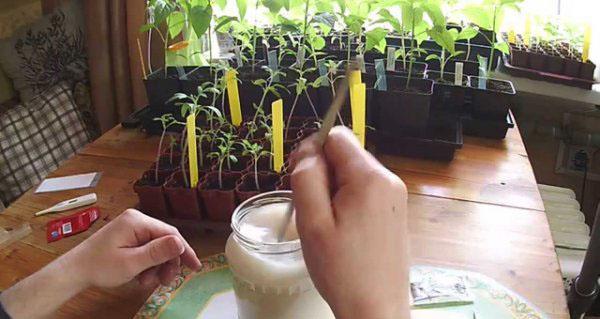

When to plant eggplants according to the lunar calendar
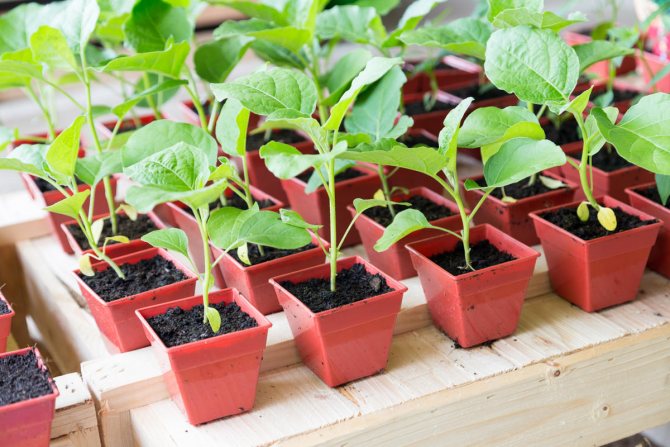

The lunar calendar for planting eggplants takes into account the movement of the earth's satellite along a large stellar path around our planet. Favorable days for sowing seeds fall on the waxing moon phase and the first part of the waning month.
It is advisable to adhere to a system that has been deduced for many years in connection with the deduced repetitive patterns. Sowing seeds and caring for seedlings is more effective during a successful merger of the Moon and certain zodiacal constellations that favor the event. This approach will help to attract the cosmic energy of the lunar influence in favor of the intensive growth and development of plants.
Auspicious days
Eggplant seedlings are sown at the end of winter and the procedure ends in mid-spring. Planting earlier does not make sense due to insufficient light and cool weather conditions. Sowing later than April is impractical, since the vegetables will not have time to ripen before the onset of cold weather.
Schedule seed placement work on favorable days for planting eggplant:
- February - 6-8, 11-13, 20-25, 28;
- March - 8-12, 15-20, 23-25, 27-29;
- April - 1-4, 6-9, 11-13, 20-21, 24-26, 29-30.
In the north, you need to sow seeds in March in order to get strong seedlings by June. In the middle lane, sowing can be done in February and in the first month of spring for subsequent planting in greenhouses or on beds. In the southern regions, eggplant seedlings can be cooked from the first February numbers to the end of April. With the correct selection of the variety and adherence to the rules of agricultural technology, you will receive tasty and environmentally friendly blue fruits throughout the warm season.
Bad days
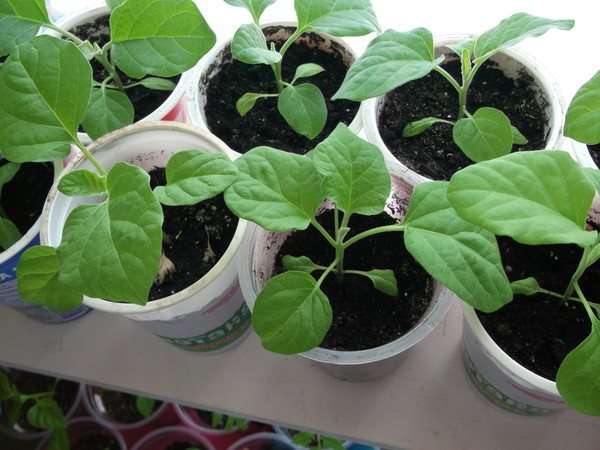

Sowing eggplant seeds should not be during the new moon and full moon, as well as during an unfavorable merger of the phase of the earthly satellite and certain constellations of the zodiac. Do not plan to plant the vegetable during the following periods:
- January - 5-6, 21;
- February - 4-5, 19;
- March - 2-4, 21, 30-31;
- April - 4-6, 19, 27-28.
Sowing on these dates is fraught with poor seed germination, pecking of weak shoots, and the production of seedlings that will be susceptible to diseases and pest attacks. You should not neglect the lunar planting calendar for gardeners and summer residents. It is better to choose favorable days for planting eggplant and the most successful time for planting planting material.
Sowing technology
Before sowing eggplants, preparatory work should be carried out on the choice of soil and seeds.
Soil preparation
Eggplant seedling mix can be purchased at the store or made on your own. The soil should be loose, breathable, nutritious. The acidity reaction should correspond to pH 6.5.
When buying a ready-made potting mix, pay attention to the content of the main components: phosphorus, potassium nitrogen. If their quantity is from 300 to 400 mg / l, then the soil is suitable for sowing. The deviation of the content of trace elements in the big direction, says that such a soil is used only as a component. Or for planting eggplant seedlings after picking, adult specimens.
Since this will entail a set of green mass, active growth. The formation of flower brushes, buds, unfortunately, will be slowed down.
The soil for self-cooking is prepared in the fall. The classic version contains the main components:
- low-lying peat;
- garden land;
- sawdust;
- humus.
Peat can be found in a swamp, the first layer is superficial, the second layer is considered to be low-lying, feeding on deep waters. It is he who should be collected. Humus can be replaced with rotted compost. If there is no hardwood sawdust, replace with river sand. Mix the components in the ratio: 1: 2: 1: 1.
It is necessary to increase the nutritional value of the soil with complex mineral fertilizers. Add 40-80 g to a bucket of main components.
The second option is a mixture:
- garden land - 1 bucket;
- ash - 100 ml;
- superphosphate - 1 tbsp. l .;
- potassium sulfate - 1 tsp;
- urea - 1 tbsp. l.
It is better to collect vegetable garden soil for eggplants from under cucumbers or cabbage.
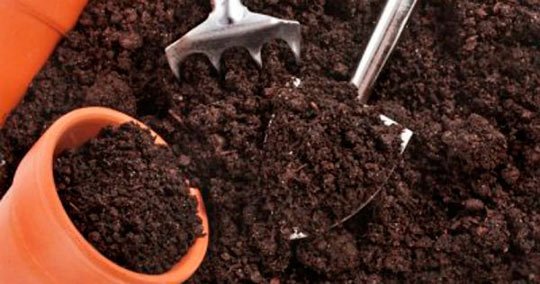

Disinfection
All components must be disinfected. There are several ways to do this:
- The simplest way is to freeze it. The earth is sent to a linen bag and hung on the balcony at an air temperature not lower than minus 15 degrees C. The procedure continues for 7 days. Then, the bag is brought into heat to wake up all the parasites. Repeat freezing after a week. As a result of 3-fold freezing, the parasites will die. The disadvantage of the procedure is that the plant does not get rid of late blight. For soil with vermicompost, this method is also undesirable.
- Heat treatment. It is carried out in two ways: calcining, steaming. Steaming - the earth is poured onto a baking sheet in a 5 cm layer and poured over with boiling water. In an oven heated to 90 degrees, the mixture is set for 30 minutes. Steaming - soil is poured into the bag and placed on a metal mesh. She, in turn, stands over boiling water. Steam treatment is carried out for 1, 5 hours. Heat treatment should be done according to the instructions. Deviation leads to a deterioration in quality. Since the soil is sterile, you cannot sow seeds right away. The mixture is sent to a room with a temperature of +12 degrees for 2 weeks. The environment helps the formation of beneficial microflora.
- Soil treatment with fungicides. The line of drugs is aimed at enhancing the immunity of seedlings, suppressing pathogenic bacteria. When using any drug: Alirin-B, Baktofit, Agat-25K, follow the instructions.
- Disinfection with insecticides.Chemicals: "Iskra", "Aktara", "Tanrek" are aimed at destroying pests in the ground. Before processing, the land is moistened and treated with insecticides. The procedure is carried out one month before planting the eggplants.
- Disinfection with potassium permanganate. The solution is prepared from the proportions: 5 g per 10 l of water. For each square. meter of soil should be at least 50 ml. At least 14 days must pass before sowing.
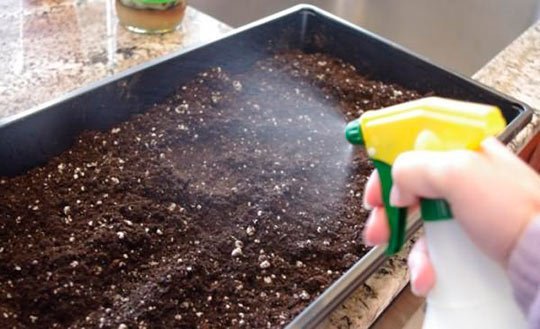

Eggplant is very sensitive to acidity. This can be taken care of during the preparation of the soil. To do this, use dolomite flour, lime, ash.
Seed preparation
Buying eggplant seeds should be from reputable producers. Pay attention to zoning and shelf life. Although seed germination lasts 5-6 years, gardeners are advised to use fresh planting material.
For those who collected seeds from eggplants on their own, it is necessary to carry out preparatory work for sowing.
Calibration
Pour eggplant seeds on the table and calibrate. Remove rotten, deformed, not native color, with spots, seeds. Separate the coarse grains from the fine ones. The fact is that their germination capacity will be different. Therefore, it will be necessary to sow them in separate groups. The planting material is checked for germination in another way: the seeds are immersed in a saline solution of 3%. Stir until there are no bubbles. After a few minutes, the eggplant seeds that have emerged are thrown away, and the good ones are dried.
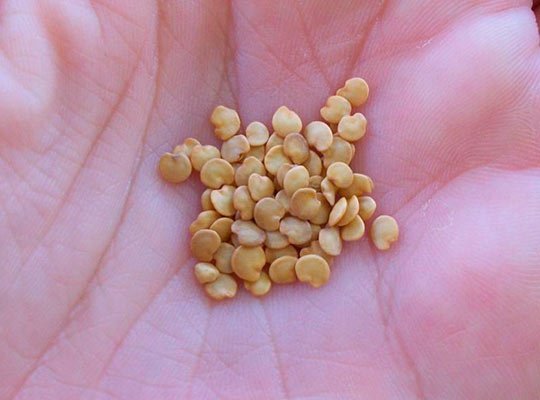

Disinfection
The purchased material is not processed, since the manufacturers have already taken care of this. And for home seeds or purchased on the market without packaging, it is necessary to disinfect with potassium permanganate. Dip the seeds in 1% working solution for 20 minutes.
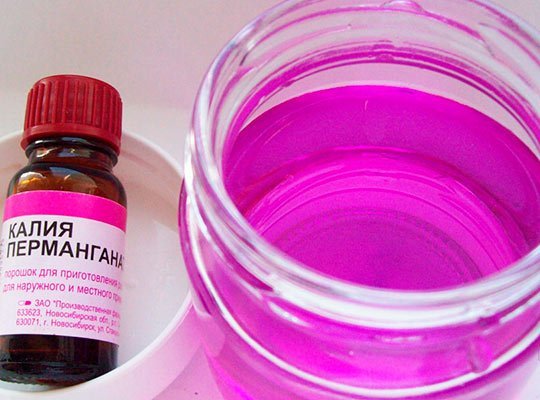

The second method of disinfection is heat treatment. Eggplant seeds are alternately dipped in hot water (50 degrees) for 20 minutes, then moved to cold water for 1 minute. In a solution with trace elements, the seeds are kept for 12 hours and sent to the refrigerator for 24 hours. Take out and dry a little for flowability.
Stimulation
To speed up the harvest, eggplant seeds are dipped in a solution: 1 tsp. nitrophosphate for 1 liter of water. The chemical can be replaced with ash or sodium humate. The temperature of the working solution should be in the range of 25-30 degrees. After 24 hours, the grains are taken out and sprinkled with a little water to ripen.
Germination
The last step before sowing seedlings is germination. Cover the eggplant seeds with a napkin and moisten until moist after stimulation. Place the container in a warm place, such as a battery. When roots appear up to 3 mm, the planting material is ready for use. The method is used to accurately diagnose that the seeds will sprout. They also speed up the germination of eggplant seeds. Plantings with roots receive seedlings as early as 5 days.
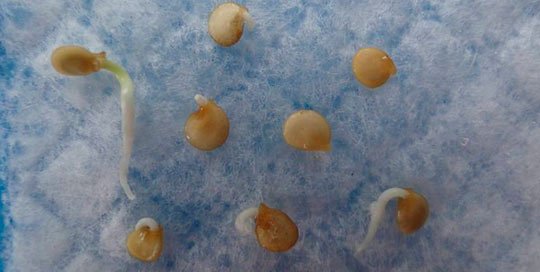

Sowing
Before planting seedlings, eggplant seeds are hardened. Place them in the refrigerator for 5 days. They are pulled out and kept for 24 hours at a temperature of 25 degrees. Then, again in the refrigerator for 2 days (0 ... + 2 degrees). After the next hardening, the eggplant seeds are sent to the soil after the refrigerator. During hardening, moisture must be monitored.
Eggplant seedling care
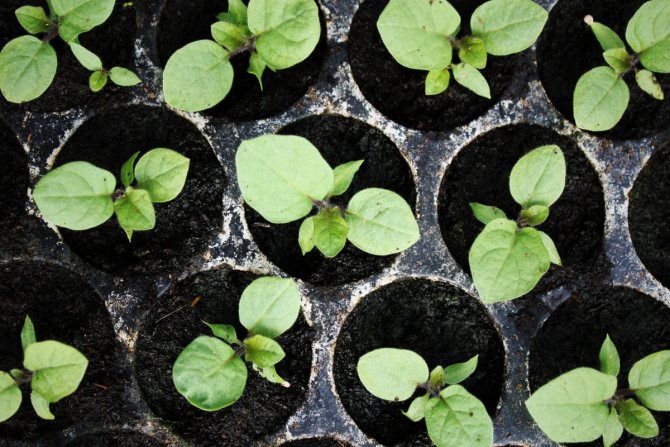

Solanaceous plants are demanding not only to observe a favorable time for sowing seeds, but also to timely and regular care of the seedlings. Sown vegetables must be fed, watered, treated against diseases and pests in a timely manner. It is undesirable to dive plants at the stage of growing seedlings. The culture does not tolerate transplantation and adapts to new conditions for a long time.
Favorable periods for caring for eggplant seedlings take into account the most successful location of the Moon and the constellations of the Zodiac, which favor certain types of work
| Fertilization | Seedling treatment with pests and diseases | Dive | Watering | |
| February | 13-14 | 18-19 | 28 | 6-7, 15-16, 23-25 |
| March | 22-24, 26-27 | 17-18 | 1-2, 10-12, 15-16, 28-29 | 5-6, 15-16, 23-24 |
| April | 1-9, 11-13, 20, 24-25, 29-30 | 13-15 | 2-3, 7-8, 11-12, 20-21 | 1-3, 11-12, 19-20, 29-30 |
Do not deal with plants during the transition phase to the new moon and during the full moon. At this time, crops do not tolerate any impact on the green parts or the root system.During these periods, you can do planting planning, reading special literature, cleaning the territory. It is also not recommended to cultivate the land.
Diving eggplant
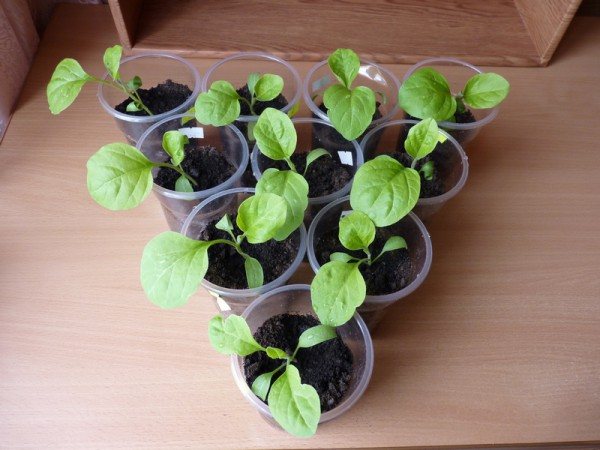

With mass sowing of seedlings, one of the care measures is timely picking. If you did not plant one seed at a time in a separate container, transplant and separate the seedlings with transfer to an individual container with a volume of at least 0.5 liters. This is necessary so that each plant receives enough nutrients, moisture, sunlight, and does not compete with other bushes.
The dive must be done on days favorable for the procedure. Schedule work on thinning eggplant seedlings with transplanting seedlings for the following dates:
- February - 28;
- March - 1-2, 10-16, 28;
- April - 2, 7-8, 11-12, 20-21;
- May - 8-14, 17-18;
- June - 5-6.
Seedlings are dived only with a full-fledged third leaf that has grown. If you divide and transplant seedlings earlier than this period, the culture may die.
Fertilizing eggplant
Growing nightshade seedlings requires regular fertilization under the seedlings. During growth, seedlings need nitrogen, which contributes to the active development of green parts of plants. At least three times it is necessary to fertilize the soil with ammonium nitrate or nitroammophos. Once every 15 days, the eggplant nursery needs to be fed with potassium supplements. You can add wood ash or a ready-made fertilizer.
Seedlings should be fertilized with organic compounds every 20 days. It is better to prepare liquid infusions, they are absorbed faster by the root system of the vegetable and saturate the soil with nutrients. Prepare a slurry from rotted cow dung, rotted compost, or humus. Water the seedlings on favorable lunar days.
Preplant seed preparation
If the seeds are not prepared in advance, you will have to wait for their germination for a very long time - 14, or even all 20 days. Preparing the seeds in advance before sowing allows them to accelerate their germination for several days in advance.
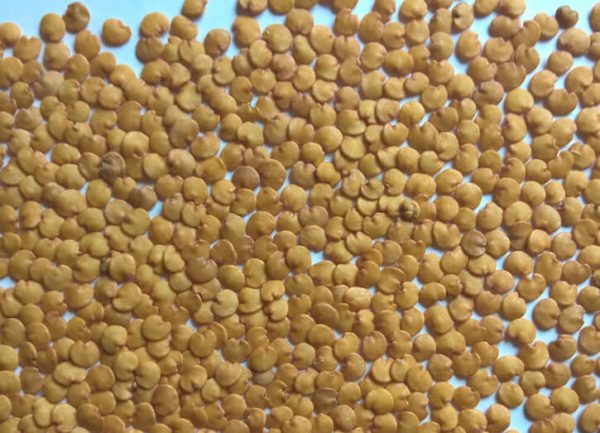

Pre-preparation of eggplant seeds not only improves germination, but also eliminates many seedling diseases
If a gardener harvests seeds on his own, he must indicate the date of selection on the package with planting material. Seeds are recommended to be stored for no more than 4 years. At the end of this period, they lose their qualities and become unsuitable for planting (not similar).
Pre-planting seed preparation consists of the following stages:
- Sorting.
- Disinfection.
- Treatment with a growth stimulating drug.
- Germination.
The last stage is allowed to be omitted if there is confidence in the good quality of the acquired planting material from a reliable manufacturer.
Sorting
Seeds are selected by weight, small and damaged specimens are removed. Sorting is carried out by means of a 5% sodium chloride solution (1 liter of water and 50 g of salt). The seeds are kept in it for several minutes and mixed thoroughly. Some seeds begin to float to the surface. It is the emerged specimens that are discarded, and the rest are taken out and washed with clean water. They will be the planting material.
Disinfection
Seed treatment against viruses and various parasites is carried out in several ways. The simplest is keeping eggplant seeds in a 1% solution of potassium permanganate for 20 minutes. After the procedure, they are washed under running clean water.
Another method of disinfection is heat treatment using a chemical agent according to the scheme:
- The seeds are placed in warm water (+ 50– + 520C) and kept for half an hour.
- Then they are immediately transferred to cool water for 2-3 minutes.
- Next, the seeds are placed in a 0.01% solution of potassium humate, which is prepared in advance. Planting material is left in it for 24 hours.
The eggplant seed has a dense shell and a protective film that prevents germination. Therefore, the use of a germination stimulator is quite justified in the case of their preparation.
Soak
If disinfection was carried out using potassium permanganate, then the seeds, after washing with cold water, are also washed with hot water to remove essential oil from them, which does not affect germination in the best way.
After that, the seeds are soaked in a nutrient composition. Take 1 teaspoon of the substance per liter of water. It can be nitrophoska, liquid sodium humate, wood ash, fertilizer - Baikal EM1, Ideal, Novosil. The seeds placed in the tissue are left in such a liquid mixture for a day. Then they are removed, washed, placed in a humid environment for pecking.
Germination
Seeds can be germinated before planting. The sprout length before planting in the ground should not exceed 5 mm. If there is no intention to treat the seeds with a nutrient composition, they should still be soaked for 12 hours in warm water and put in a humid environment (cloth, cotton pad or saucer). In a warm place, at a temperature of + 25 ° C, the planting material is kept for germination until the sprouts appear. It is necessary to control the moisture content of the substrate, preventing it from drying out.
Old seeds, which have been stored for more than one year, must be warmed up for two hours in hot water (+ 40- + 50оС) in a cloth bag before planting. This greatly increases their chances of germination.
Photo gallery: the main stages of preparing eggplant seed before planting
Features of growing eggplant and the lunar calendar
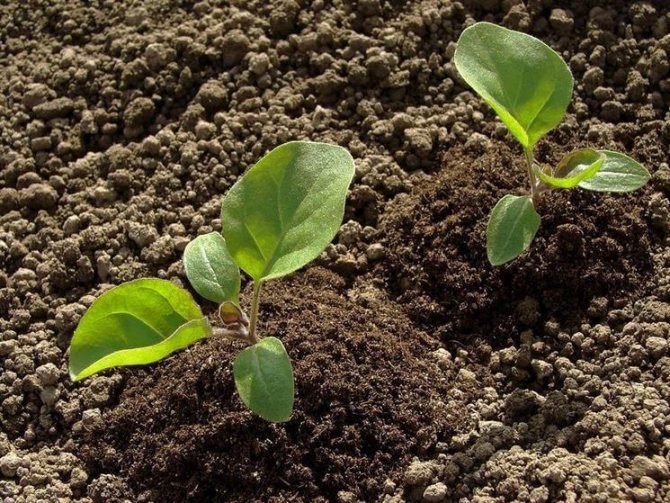

Before the summer season, study the information on growing eggplant to take into account all the factors for effective crop production. You will get strong and healthy vegetable seedlings, which will give you a rich harvest of juicy fruits.
Consider the following aspects when sowing, nursing, transplanting eggplant seedlings:
- adult seedlings suitable for transplanting into greenhouses or garden beds must be at least 75 days old. Compliance with this period will allow you to get healthy bushes that quickly adapt to new conditions, will have a strong immunity to diseases and pests, actively develop and bear fruit;
- analyze the weather conditions during planting and transplanting seedlings, as well as favorable times according to the lunar calendar. It is necessary to attract a whimsical vegetable to the natural energy of the influence of an earthly satellite in order to strengthen the plant's own resources;
- provide favorable conditions for growing sprouts and adult seedlings. Keep the nursery in a warm place (the optimal temperature is 25 degrees), with sufficient light. After transplanting mature seedlings, make sure the greenhouse is equipped with heating devices or weather conditions permitting the growth of thermophilic nightshades;
- plan timely watering of the seedlings. Drying and waterlogging of the soil must not be allowed. Use a spray or spray bottle when watering. Water should be at room temperature, separated or filtered;
- choose the right varieties so that vegetables have time to ripen in your climatic region. You should not sow late-ripening eggplants in late spring in the north, the culture will not have time to give ripe fruits.
As an example, consider the Leningrad Region. Experienced summer residents know that steady heat in the region occurs after the first ten days of June. The first autumn frosts, which will prevent heat-loving eggplants from growing in the greenhouse, will come in mid-September. Thus, the appropriate period for growing a crop is 115 days. You need to pick up a hybrid that needs at least the calculated days between shoots before the harvest time. Gardeners of St. Petersburg and the surrounding areas choose early-ripening varieties for planting and plant so that the culture has time to ripen.
Diseases and pests
The most common diseases in eggplant are late blight, black leg, mosaic, gray rot or stolbur.
Signs of infection with infectious and fungal diseases are:
- wilting and yellowing;
- the appearance of a variegated color;
- blackening of the stem or staining of the foliage in a purple-red color;
- deformation, drying.
If the foliage turns yellow, holes appear, it is quite possible that pests have settled on the eggplant. "Love" culture:
- aphid;
- spider mite;
- transparent or naked slugs.
These insects feed on the sap of the plant, so the foliage dries up, withers, and curls. If a void appears on the trunk (lack of greenery) - slugs. Pests quickly eat eggplants, leaving only dried veins in their place.
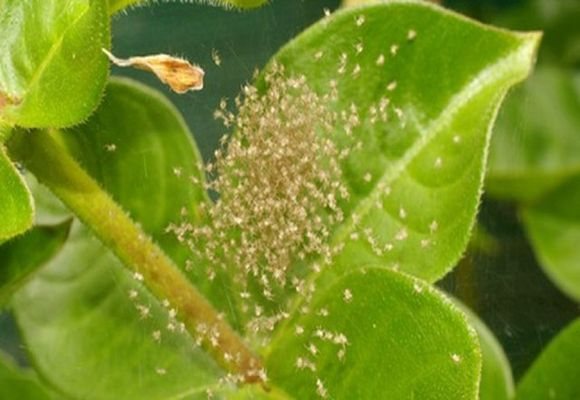

Preparing eggplant seeds
It is necessary to prepare planting material in order to improve germination. Eggplant seeds are suitable for sowing for 8 years. After 5 years, the quality of the seeds is significantly reduced. To speed up the hatching and provoke an active growth of seedlings, you need to prepare the crops, which can be started at the end of winter.
Cook nightshade seeds in the following sequence:
- select the desired variety in accordance with the ripening period and climatic characteristics of the region;
- disinfect the seeds in an aqueous solution with the addition of potassium permanganate. This will exclude the entry of infected material into the plantings. Exposure time - 30 minutes;
- soak the seed in warm water. Without mixing the varieties, put the planting material in cheesecloth, place the bookmark in saucers with warm water and put it in a warm place.
Useful! To exclude dry and unusable seeds from planting, soak the seedlings in room temperature water for half an hour. Remove floating seeds.
For effective disinfection, you can prepare a solution of copper sulfate (0.2 g), potassium permanganate (2 g) and boric acid (0.4 g). All components must be mixed and dissolved in 2 liters of water. Moisturizing the tough peel and the penetration of water molecules into the seed catalyze all processes inside and activate the growth of the culture.
How to care for eggplant seedlings
After planting the eggplant seeds in the selected containers, they are removed to a warm place. But at the same time, it should be shaded.
As soon as the shoots appear, they move to a well-lit place. The temperature regime does not change from the very beginning: 26-28 degrees.
Water the eggplant regularly. If planted in peat tablets or pots: the amount of liquid is doubled. Reason: Peat takes up a lot of liquid. Illumination for at least 12 hours a day.
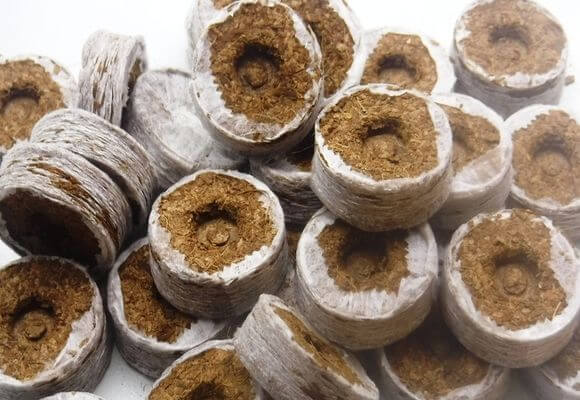

Care before germination
Seeds are necessarily processed in special solutions before planting. But this is not enough for the film to burst and sprout.
The pots should be opened every day to ventilate and harden the plant. The first days, the procedure is carried out for 2-5 minutes. Then the time interval is increased.
Picking
Thinning eggplant seedlings or diving is not necessary if the seed was planted at a certain distance (4-5 cm). The leaves will not join.
When grown in snails, the workpiece is unfolded, and the seedlings are transplanted into different cups. This simplifies the picking process.
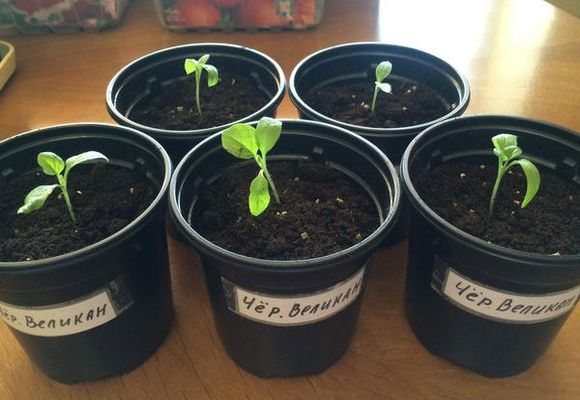

Temperature and light
Eggplants love warmth. Therefore, the air temperature should not be lower than 26 degrees. At low temperatures (18-24 degrees), the seeds will also grow, but with a great delay. As soon as the sprouts begin to develop, the temperature regime drops to +20.
If initially the seeds require a lot of heat, then with the appearance of the leaves, a lot of light is needed. During the day, the eggplant should be in natural sunlight for 12 hours.
Since this is not always possible, special non-incandescent lamps are used. This will save the culture from the occurrence of burns.
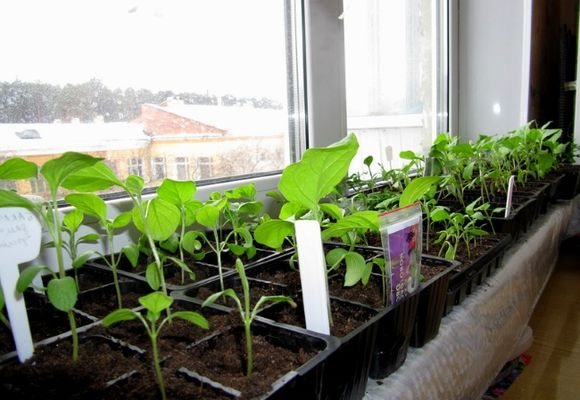

Watering and feeding
Water for irrigation is taken exclusively at a distance of at least 48 hours.Necessarily warm. Watering in the evening with warm water.
Iodine (1-2 drops) can be added to the liquid for disinfection and additional feeding of the culture. Water should be abundant so that liquid appears from the drainage holes.
The first time eggplants can be fed only 14 days after germination.
It is recommended to feed:
- Gumi Omi or ash;
- Kornerost, Agricola;
- Kemira or Fertik.
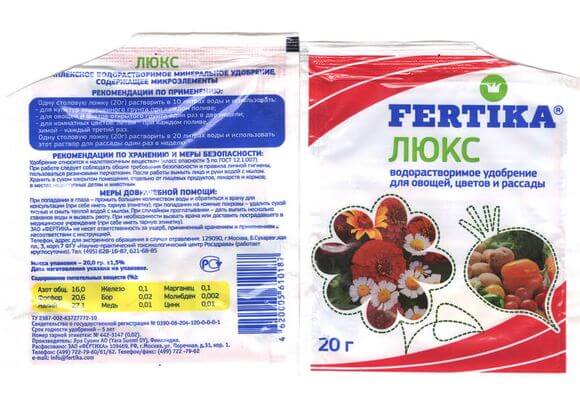

Do I need to pinch?
The eggplant pinching procedure is carried out as needed. Not recommended if:
- undersized variety;
- dry summer;
- desire to grow smaller fruits. Pinching increases the weight of the fetus;
- green part with dense healthy leaves.
The main disadvantage of the procedure is that it injures the plant.
Disease prevention
To avoid infection with fungal diseases, to prevent long-term treatment of eggplant seedlings, you should think about preventive treatment.
What soil to sow
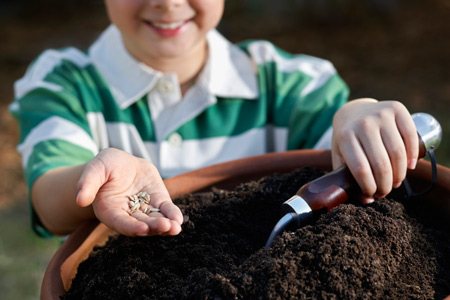

Eggplants are demanding on the fertility of the soil into which the seeds are sown. Prepare a quality seed potting substrate that contains all the trace minerals and nutrients you need to grow vegetables.
The soil should have a light structure, be filled with fertile organic matter. Prepare your own mixture in which the eggplant seeds will have optimal conditions for hatching and growth. In a large container, mix:
- garden land - 1 part;
- organic filler (rotted manure, compost, humus) - 1 part;
- wood ash - ¼ part;
- nitroammophoska or superphosphate - 1/8 part;
- river sand - 1 part.
For planting, take a seedling box or individual planting containers. You can use ready-made peat pots, plastic cups with removable bottom, or plastic bags for dairy products. The use of a single container will facilitate the process of transplanting adult seedlings to a permanent growing site.
Landing
Sowing soil can be purchased in stores, or you can prepare it yourself. This requires mix 2 thirds of humus and one third of peat or you can choose another option.
For sowing, you can choose small cups, pots or other containers. Landing is done in the following order:
- Fill containers with soil by ¾;
- Place the seeds in the center of the cups;
- Sprinkle them with earth;
- Drizzle.
TIP! Seedlings are best covered with plastic wrap and placed in a warm place with a temperature of at least 25 degrees.
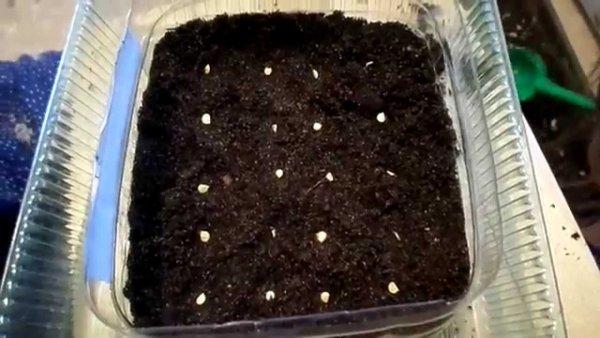

How to sow eggplant
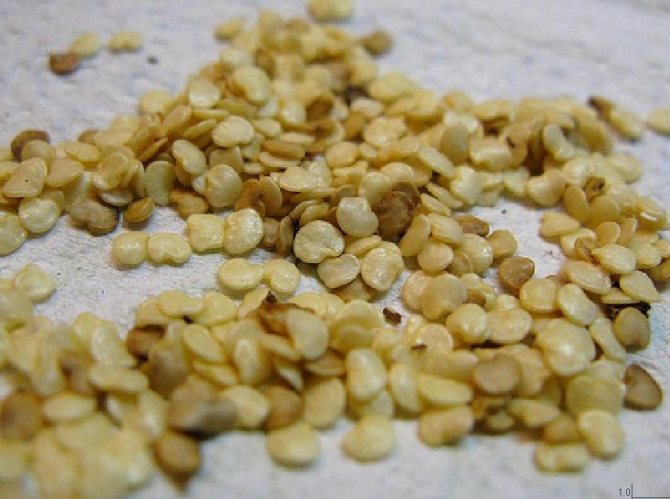

Solanaceous seeds of this species do not tolerate picking and transplanting well. It is advisable to sow seedlings with the embedding of seeds, one piece in an individual container. The container must have a volume of at least 0.3-0.5 liters. This space will be enough for the full development of an extensive root system and active growth of green parts of the culture.
Sow the planting material using the following steps:
- prepare the ground, prepared seeds, water at room temperature, a spray bottle, containers for planting, a spatula;
- fill the container with fertile soil for crops;
- moisten the ground with a spray gun. Avoid waterlogging;
- make indentations 1 cm deep;
- dip 1-2 seeds into the hole;
- sprinkle with earth;
- water the planting site evenly;
- cover the surface with polyethylene to create a greenhouse effect;
- remove the container with seedlings in a warm and sufficiently lit place.
For mass planting of seedlings in seedling boxes, fill the container with soil by 2/3, moisten it with a spray bottle with warm filtered water. Cover the seed by sowing in rows to a depth of 0.5-1 cm or place the crops at a distance of 8-10 cm from each other.
Planting in separate containers should also be done at a shallow depth. The deeper the seed is buried, the more difficult it will be for the seed to hatch. You can plant 2 seeds at a time to remove the weaker plant later.
Harvesting and storage
The ripening time is determined by the type of eggplant. Technical maturity is also determined by the color of the fruit: dark purple. At the same time, the pulp should be elastic, juicy, without voids. All the eggplants do not ripen at once. Therefore, it will not work to harvest all the fruits.
Do this as it ripens every week. Cut with pruning shears or scissors treated in a manganese solution.
You will not be able to store eggplants for more than 3 weeks. For the longest possible storage indoors, observe:
- temperature within 1-2 degrees with a plus sign;
- humidity not less than 90%.
Eggplant is an excellent salting for the winter. They are not only consumed in the form of caviar. Many recipes allow you to preserve the taste of the original fruit. You just need to look at the websites of culinary specialists.
Recommendations for the care of eggplant seedlings
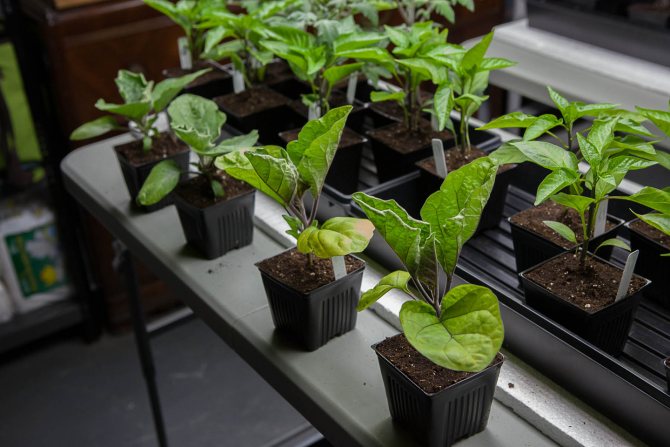

Planting boxes and containers should be kept in a warm place. The soil temperature should not drop below 15 degrees. After germination, regular maintenance activities should be planned. To grow healthy, disease- and pest-resistant seedlings, provide your plants with:
- the temperature in the area of growing seedlings is from 25 to 28 degrees. When the thermometer drops below 23 and above 30 degrees, the growth rate of the culture decreases;
- regular ventilation. Overmoistening of the soil and air should not be allowed, as this can provoke a weakening of the bushes and reduce immunity;
- uniform watering. When watering, use a sprinkler or spray bottle that will provide drip irrigation;
- exclusion of water getting on the leaves. Water directly under the root of the plant;
- sufficient illumination. It is important to provide the culture with light, but protect the plants from direct sunlight. To do this, you can install a screen made of white or newsprint;
- weeding. On favorable days according to the lunar calendar, remove weeds, which are a competitor of eggplants;
- loosening the earth. Hilling plants and loosening the soil every 10 days. This will give oxygen access to the root system for the full development of the root system and better wetting of the soil.
Watch for the heel of the bushes. To prevent the seedlings from stretching towards the light, regularly turn the container with seedlings in the opposite direction. Long seedlings are weaker and prone to mechanical damage. Observing all the recommendations for planting and care, you will get strong seedlings that will safely transfer the transplant to a permanent place and give a rich harvest of fruits.
Useful materials
Read other articles on growing and caring for eggplant seedlings:
- Different growing methods: in peat tablets, in a snail and even on toilet paper.
- All the features of sowing according to the lunar calendar.
- Features of cultivation in various regions of Russia: in the Urals, Siberia and the Moscow region.
Transplanting eggplant seedlings
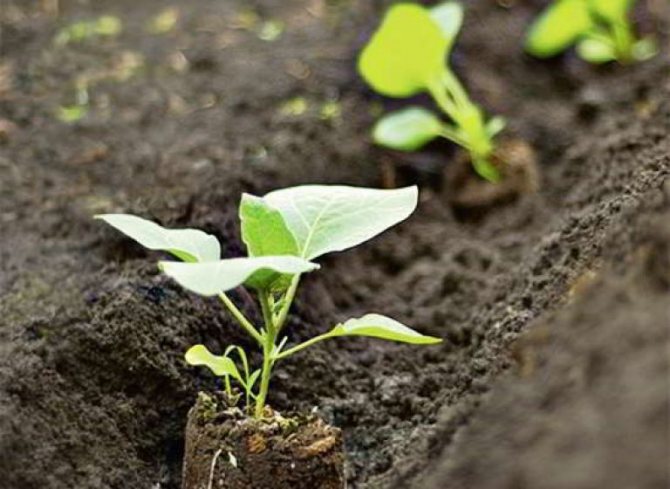

As soon as the eggplant bushes reach the desired size and at least 75 days have passed since the seeds are pecked, the seedlings must be transplanted to a permanent place. In the south, it can be an open bed with warm soil, in the middle lane or in the north, the transplant should be done in a greenhouse structure. It is important that the soil does not cool below 15 degrees at night.
The transplanted vegetables should be given similar conditions in which the seedlings grew. Greenhouse conditions or beds should be heated in the daytime at least 22 degrees during the day. Move eggplants to open areas without darkening by large trees or outbuildings.
Preparing seedlings before transplanting
Consider the following factors before transplanting:
- temper the seedlings. A week before the planned transplant, take out pots with seedlings to the balcony or street to prepare the plants for new conditions. Increase the holding time of the seedlings every day. Start at 1-2 hours;
- transplant no earlier than 3-4 adult leaves are formed on the bush;
- transplant the plants into soil that is similar in composition to the seedling soil. Fertilize garden or greenhouse soil;
- after transplantation, provide the culture with rest for at least a week;
- do watering only 3 days after transplanting.
Transplanting bushes in the southern regions should begin no earlier than May, in the middle lane - in early June, in the north at the end of the first summer month.
Transplant mechanism
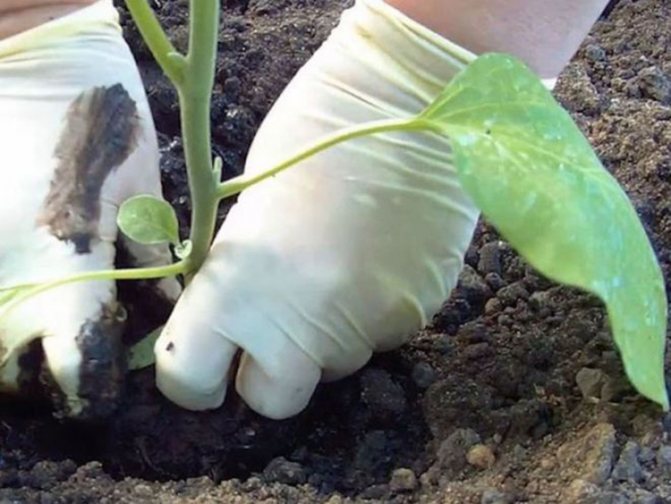

Before transferring adult eggplant seedlings to a permanent growing site, the territory must be prepared. Transplant the culture according to the following algorithm:
- dig the earth 25-30 cm deep;
- fertilize the soil with organic matter. Add rotted manure, humus, or matured compost;
- apply nitrogen fertilizing and potassium supplements (for example, nitroammofoska and wood ash);
- Dig the area again to ensure mixing of the layers;
- mark the future location of the landings. The distance between rows and bushes should be at least 50 cm;
- make depressions 8-10 deep and the same in diameter;
- place the seedling along with the seedling soil in the prepared hole;
- sprinkle the planted bush with earth;
- lightly tamp the surface of the soil;
- water with a sprinkler or spray bottle.
Interesting! If you grew eggplants in a peat container, you do not need to remove the bushes from it. Place the seedling right away with the peat pot
After transplanting seedlings, leave the plants alone. It will take them at least 7-10 days to become juiced and look healthy. Carefully ventilate during this time.
Sowing seeds in open ground
As I said above, sowing eggplants for seedlings directly into open ground is not recommended, but if you still chose this method, then let's consider the features of such sowing.
So, you will need the following materials:
- eggplant seeds;
- shovel;
- humus;
- bird droppings;
- mineral fertilizers;
- film;
- urea;
- capacity;
- gauze;
- water;
- mullein solution;
- peat;
- manure.
Work process:
1. First of all, you need to choose a suitable place for sowing. It should be sunny and sheltered from the wind. Dig up the soil and add humus and peat to it. Plus, you can add more manure if your soil is not loamy and does not differ in fertility. But the manure should not be rotted.
2. Now you need to form the beds. Their height should be about 30 cm. But the width should not be more than 1 meter. Do the length at your discretion. The bed must be leveled and watered abundantly with hot mullein solution.
3. Next, take the eggplant seeds and transfer them to a container, cover with water and cover with gauze. Leave in this form for a few days. Wait for them to sprout. The gauze needs to be moistened as needed to maintain the greenhouse effect.
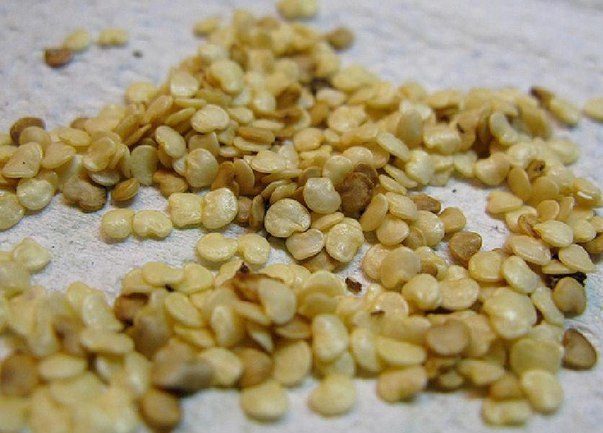

4. After all this, proceed directly to planting seeds in open ground, on the prepared beds.
Be sure to check the temperature of the topsoil, it should be at least 15 degrees.
5. Plant the seeds at a shallow depth (2-3 cm), and then water well.
6. Remember that eggplants are afraid of the cold at night, so be sure to cover them. To do this, stretch plastic wrap over the wire arcs. You can remove it only by mid-July. But if there are cold snaps in the summer, then also cover the plants with a film.
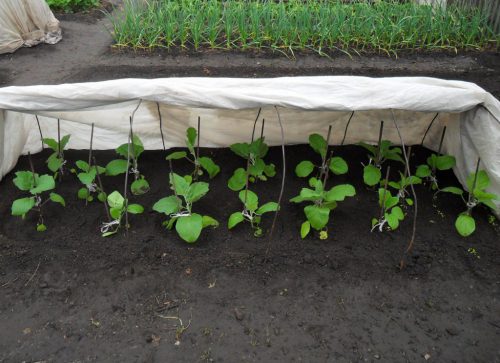

7. For the first weeks, shallowly loosen the beds, so more air will begin to flow to the roots and this will increase the growth of the seedlings.
8. Watering infrequently. But be sure to spray the plants using a urea-based composition. The soil is moistened 3-4 times a week, and feeding is carried out every month using bird droppings and mineral fertilizers.
nine.If there is a lack of moisture, the ovaries and buds of the "blue" ones will begin to fall off, and the fruits will acquire an ugly shape.
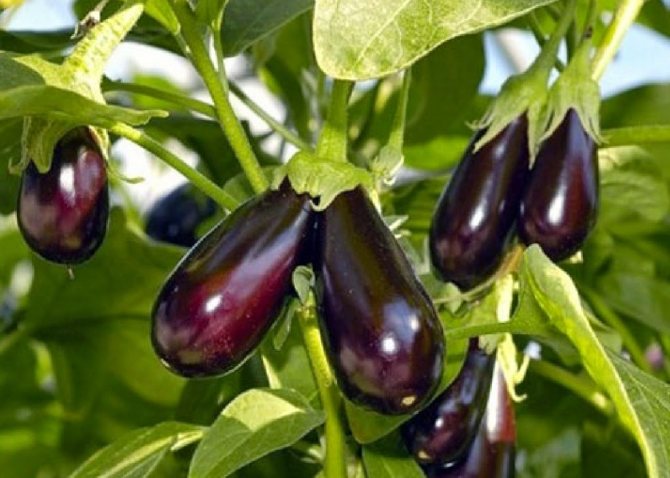

Eggplants should never be planted after nightshades. It is better to choose beds where cucumbers, carrots, onions, cabbage or legumes previously grew.
But it is best to grow eggplants as seedlings at home, and only then transplant them into open ground. Since this method allows you to get an early and large harvest.
What mistakes should be avoided
To effectively grow eggplants, enjoy the process and get a rich harvest of vegetables, you should avoid common mistakes vegetable growers make when growing this crop:
- plant only quality seeds;
- before sowing, be sure to prepare the seed by disinfection and soaking;
- plant seeds to a depth of no more than 1-2 cm. Seedlings will hatch hard if they are buried deep. Seeds can rot;
- don't plant too early or too late. Calculate the required period for the ripening of the vegetable;
- provide favorable conditions for the culture - good ventilation, warmth and light;
- do not overfill or overdry the earth. Watering should be done by spraying under the root at intervals of 1 time in 2-3 days.
Growing eggplants must be done in compliance with all the rules of agricultural technology and culture requirements. The vegetable should be planted only on favorable lunar days. This will infuse the seedlings with natural strength and help produce healthy seedlings.
Advantages and disadvantages of growing eggplant through seedlings
A positive moment when growing eggplants through seedlings is getting a natural, environmentally friendly product. When buying seed material, there is no guarantee that the seeds are of high quality and will grow.
Through seed planting, the farmer sees the quality of the seed. Those unfit for germination are immediately removed. If you sow eggplants directly into the ground, then the chances of getting healthy seedlings are minimal.
The disadvantages include:
- adherence to temperature. Eggplants are thermophilic and do not tolerate sudden changes, any temperature changes at the initial stage of development;
- you need constant lighting and maintaining the right humidity;
- with a lack of moisture in the soil, eggplants begin to hurt. But an overabundance also leads to a deterioration of the root system.
Sowing eggplant seeds and early care
At a distance of 10 cm from each other and a depth of no more than 0.5 cm, the seeds are sprinkled on top with a small layer of loose soil, just to hide. Germination can be delayed if the seeds are simply sown in the ground. Therefore, place the containers in a warm place, cover with a plastic bag to retain heat and moisture, and make sure that the soil does not dry out. If all heat conditions are met, the seeds will germinate within 10 to 12 days.
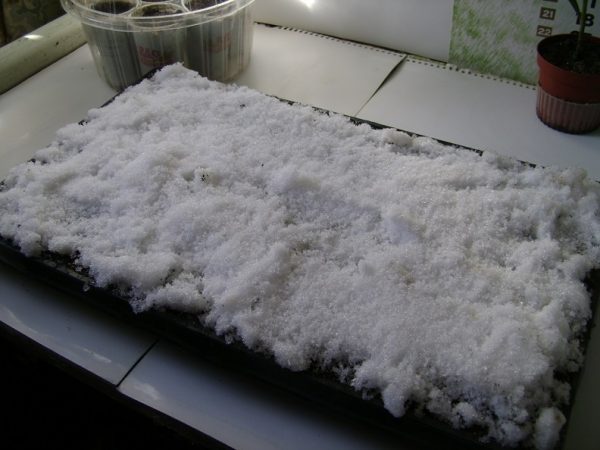

The day before sowing, the soil can be moistened with melted snow water
With the appearance of the first shoots, the film should be removed and the containers should be moved to a light, cool windowsill. This will give the seedlings an opportunity to strengthen their root system, and not start growing immediately. After a week, the seedlings can be fed with fertilizer with a high phosphorus content.
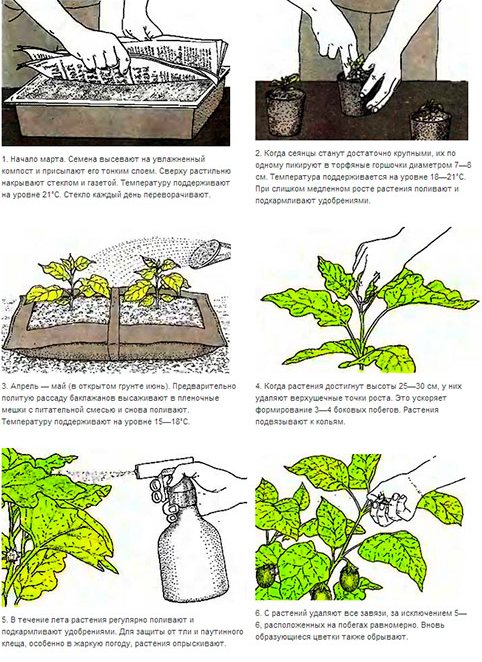

The key to a good harvest is timely care.
As soon as the first 3 - 4 leaves grow, the seedlings, if they are not planted immediately in separate pots, should be transplanted. A couple of hours before the pick, the plants are well watered and later transplanted in separate containers each, deepening cotyledon leaves into the ground.
Now you can rearrange the pots on a sunny windowsill, since the seedlings need good lighting, if there is not enough of it, the plants need to install additional lighting.
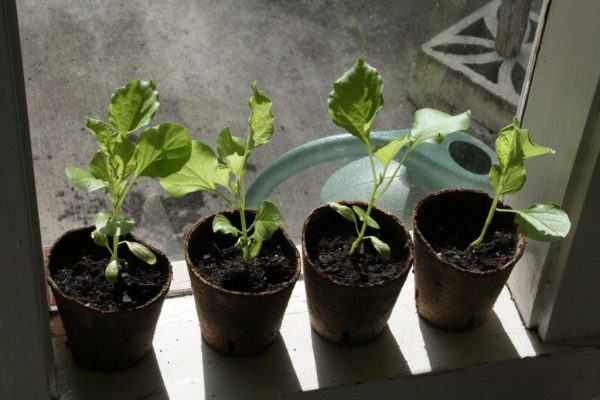

Seedlings of eggplants on the windowsill
If you do not install additional light sources for seedlings in a timely manner, it will begin to hurt and stretch out strongly.
Two weeks after picking, young plants can be fed with mineral fertilizers, at the rate of 10 liters: 5gr. urea + 30g.superphosphate.
Superphosphate prices
superphosphate
Important! During the seedling period, eggplants need abundant watering.
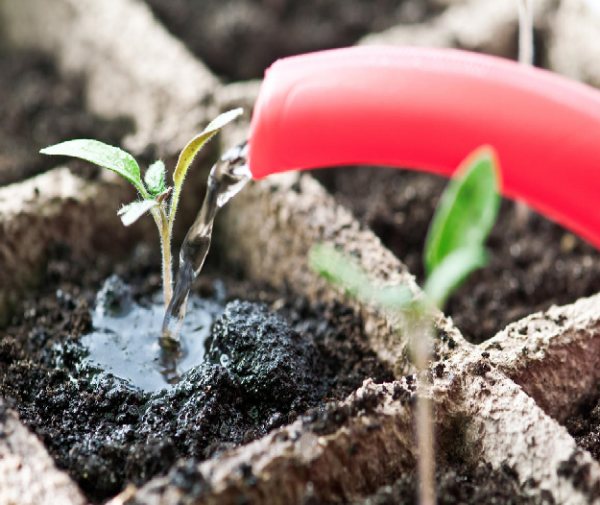

Top dressing can be combined with watering
Landing in open ground
As soon as the soil warms up to a stable temperature of 15-16 C, and the last frosts pass outside, the eggplant seedlings are ready for transplantation. A week before, the plants need to undergo a hardening procedure, so they will take root better and experience less stress. To do this, the seedlings are taken out on the balcony, in direct sunlight, every day increasing the stay by a few minutes, no longer than 2 hours a day.
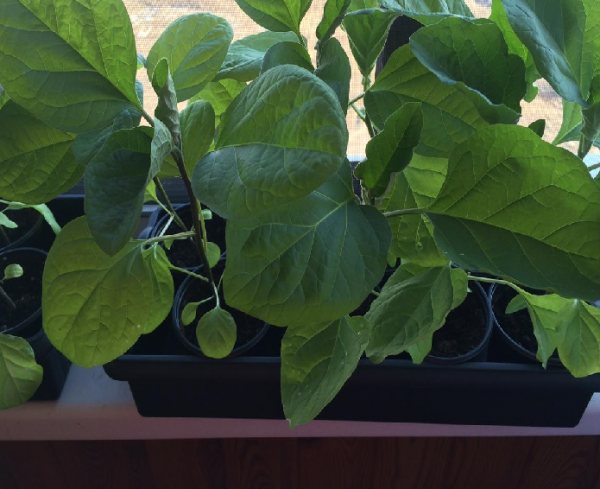

For the health of seedlings, hardening is necessary.
In the greenhouse, it is better to prepare the soil in the fall: dig up and add manure. If necessary, in the spring, add a mixture of humus (2-3 tbsp.), Wood ash (0.5 tbsp.) And superphosphate (1 tsp.) And 2-3 liters of warm water to the seedling holes with the addition of 1% potassium permanganate ... Or three weeks before planting, we sprinkle the soil with lime and compost. It is better to plant seedlings in the evening, in two rows, keeping the distance between plants 40 cm, the depth of the hole 30 cm, between the rows 50-60 cm.
When planting eggplants according to the nesting scheme, the plants can be alternated with pepper, these two vegetable crops perfectly coexist with each other.
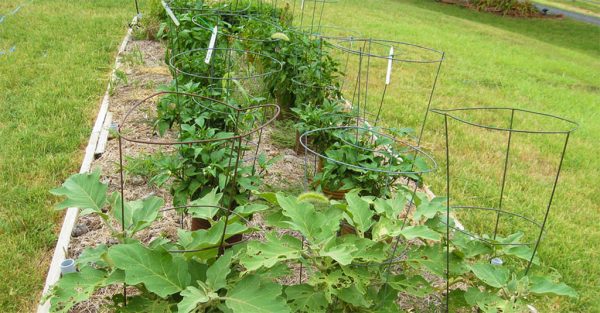

Eggplants and peppers in the same bed
Each glass is carefully placed in a hole with slurry and sprinkled with soil until the first leaves. After planting, all the seedlings are tied to supports, provided with moderate watering and two-week feeding.
Avoid fertilizers containing nitrogen, which will promote leaf growth rather than fruit formation. For the first time after planting, it is better to cover young plants with a covering material. To do this, you need to install additional arcs or other device. The covering material is removed when the night temperature stabilizes from +5 C and above.
Disease protection
There are many eggplant diseases that affect this culture, consider some of them:
Table 1. Diseases of eggplant.
| Diseases | Description |
| Fungal disease of seedlings "black leg" | affects the base of the stem, blocking the vessels and nutrition of the plant, the root area darkens, rots and the plant dies. The fungus lives in the soil, therefore, before planting, the soil must be neutralized, watered moderately, do not overfeed the seedlings with nitrogen fertilizers, and avoid temperature extremes. If you find an infected plant, it is better to remove it, spill the soil with a solution of potassium permanganate with ash and coal. |
| Late blight | at first it affects the leaves, brownish-red spots appear, then the disease spreads to the fruits and stems. After harvesting, burn the tops, and treat the soil with fungicides. |
| Sclerotinosis | a fungus that lives in the soil and eventually spreads to roots, stems and fruits. Round, leathery, rotting white spots appear at the ends of young fruits, which eventually turn black and fall off the plant, and the stems become covered with a white coating. Excessive moisture and thickening contribute to this disease. The affected areas of the plant should be removed and treated with ash, use fungicides (copper sulfate), ventilate the greenhouse. |


Seedling preventive measures will help avoid serious diseases in the future.
Diseases arise when the pre-sowing procedures of seeds and soil are ignored, excessive watering, moisture in the greenhouse and thickening during planting. Avoid these mistakes and your harvest will surely delight you.
Landing dates
In central Russia, the optimal time for sowing seeds is the second half of February - the first decade of March. You should not rush to landings. If sown early, for example, in January, the plants will stretch out until they are planted in the ground. More precisely, the sowing time can be calculated based on the period of plant development. For the middle lane, early and mid-season varieties are suitable. They need 110-120 days to fully mature.Late varieties have a longer growing season from 130 to 200 days and in the climate of the central region they are unlikely to have time to ripen.
Dates for planting seedlings in a greenhouse and open ground
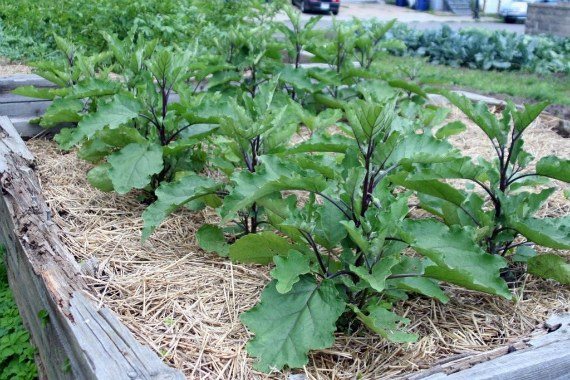

Dates of planting eggplant seedlings in open ground directly depends on the weather outside the window. By this period, the probability of recurrent frosts should be completely excluded, and the average daily temperature should be at least 18-20С. For central Russia, this is the end of the 1st decade of June. But the transplant must be preceded by a hardening procedure.
Transfer of eggplant seedlings to the greenhouse can be carried out in the 2nd or 3rd decade of May. Again, it depends on the weather conditions and the quality of the building. Before planting in a polycarbonate greenhouse, the hardening process is excluded from the list of mandatory work on growing eggplant seedlings at home.
Preparing eggplant seeds for planting at home
First, you need to decide on a container for growing sprouts, the best option is peat pots, but you can also use plastic glasses with a height of at least 7-8 cm, one per plant.
Experienced farmers independently prepare a mixture for vegetable seedlings, which must meet the following characteristics:
- be light but rich in nutrients;
- have a structure that allows you to maintain optimal humidity and allow air to pass through;
- have neutral acidity.
A substrate is prepared from one part of turf, two parts of peat and humus, a little wood ash and superphosphate (4 tablespoons) are also added there. Instead of peat, it is allowed to take soil from the garden, if peppers, tomatoes, potatoes or such a representative of the nightshade as pheasant or dog cherry have not grown on it before. Coarse sand is also added to the mixture.
Previously, many gardeners ignite all the ingredients in the oven or steam them.
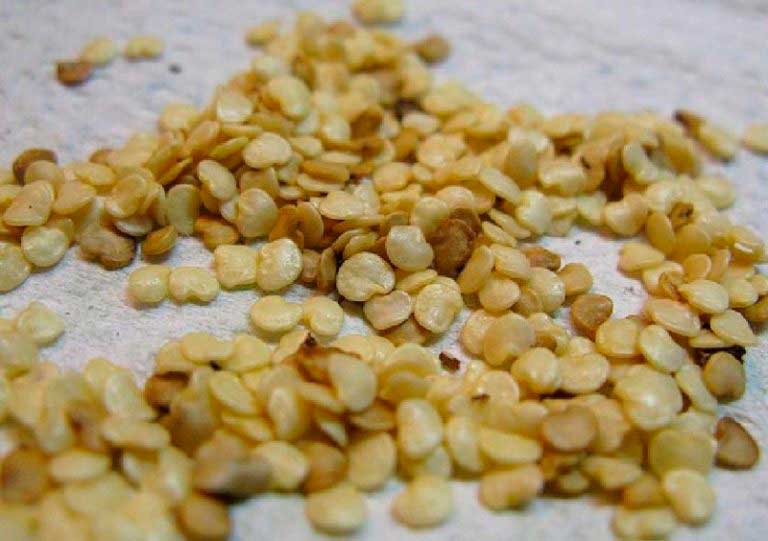

Seed preparation consists in their awakening, and has several important stages:
- whole, undamaged seeds are sorted out, cleaned of foreign particles, folded into cheesecloth and tied;
- immersed for five minutes in water with a temperature of 50 degrees;
- washed with plain water;
- soaked on the floor for a day with growth stimulants, for example, with freshly squeezed aloe juice, half diluted with water, and dried under natural conditions;
- for five days in a row, they are frozen at a temperature of +2 degrees in the refrigerator every night, and during the day they are left in the room;
- then it is necessary to germinate the seeds - they are placed on a damp cloth or gauze in a warm place for 24 hours.
The quality and volume of the harvest, in many respects, depends on the quality of the source material - you can take eggplant seeds grown by your own hands, as well as use the products of some breeding nurseries that have their own seed testing laboratory.
Watering and fertilizing
The root system of the eggplant is rather weak, do not forget about this when watering. For example, next to peppers, eggplants need more watering. In other words, this does not mean at all that the plants must be filled with water.
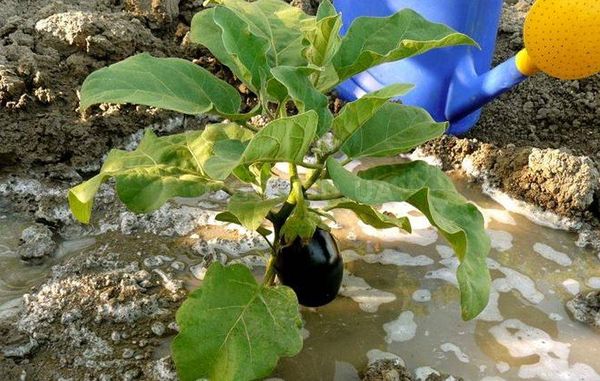

Eggplants are poured with warm water under the root.
- In unprotected soil, the main reference point is the weather, in a dry summer, watering should be done in the morning hours 2 times a day, in a rainy summer, watering is enough once every 7-10 days;
- in protected conditions, seedlings are watered once a week, immediately after planting, pause for 5 days.
After watering in a greenhouse or greenhouse, the room should be ventilated. Excessive moisture can cause illness.
Top dressing should be carried out in stages, and it will depend on the life cycle of the plant:
- The first feeding with complex fertilizer is carried out 14 days after planting.
- In the budding phase and the beginning of the formation of ovaries, eggplants need phosphorus and potassium fertilizers.
- With the appearance of the first fruits, plants need nitrogen-phosphorus fertilizers.
- A month before harvesting, eggplants are fed with superphosphates and potassium salt.
The feeding procedure is combined with watering and is carried out in the morning.
Seedling container selection
Any container is suitable for growing eggplant seedlings. These can be wooden and plastic boxes without cracks, cut plastic cans and bottles, containers and glasses, as well as special peat or coconut cassettes, pots, tablets.
Wash reused containers with laundry soap or boiling water. For the prevention of fungal diseases, seedlings of eggplant containers should be treated with any fungicidal composition ("Fitosporin", a weak solution of manganese, etc.).
Cooking seeds
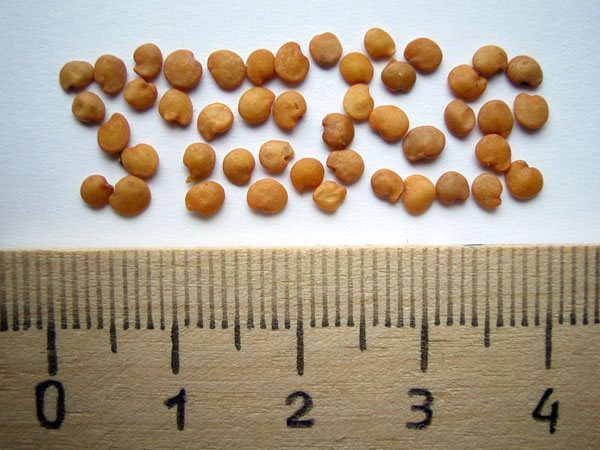

Seed size
Sowing eggplant seeds for seedlings has its own subtleties. To increase the yield it is necessary to carry out pre-sowing treatment It consists in sorting seeds by size. The largest seeds will produce the best seedlings.


Potassium permanganate solution for seeds
To rid the seeds of various diseases, it is worth soaking the selected seeds in one percent solution of potassium permanganate. After this procedure, the seeds should be rinsed with water.
You can speed up the process of germination of culture with the help of special stimulants. Alternatively, you can use boric acid diluted with water in a ratio of 5 grams per 10 liters of water.
Eggplant seedling pests and control
Eggplant seedlings are affected by spider mites and aphids - sucking pests that feed on plant cell sap. Spider mites are small insects that make tiny holes in the leaves of seedlings and entangle the seedlings with the thinnest, barely noticeable cobweb. They appear when seedlings experience a chronic lack of moisture. Aphids settle on seedlings in whole colonies, and it is also not possible to see them right away. To combat sucking insects, acaricidal preparations are used, such as, for example, Aktara, Karbofos or Aktellik. But it is better, of course, not to create favorable conditions for the appearance of pests.
Varieties, variety and features
First, decide what kind of eggplant you are going to grow. The main types of forms are spherical, elongated, cylindrical, ovoid. The color scheme is quite varied: white, purple, pink, green, black, yellow, orange, red, solid or striped.
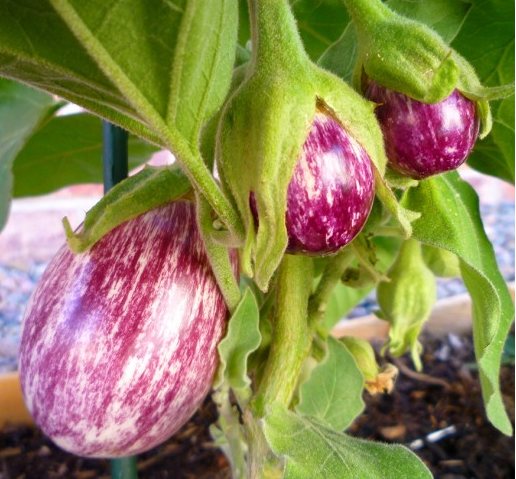

Italian striped eggplant (Rotonda Bianca)
The most common is the oval eggplant, and its large purple fruits are used for filling, casseroles, roasting and grilling.
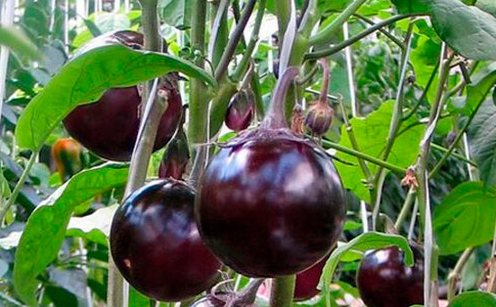

Sancho Panza large-fruited eggplant variety
Mid-season varieties Begemot, Almaz, Baikal and very early varieties Violet Miracle, King of the Market. A favorite of the northern regions, the King of the North variety.
Eggplant seed prices King of the North
eggplant king of the north
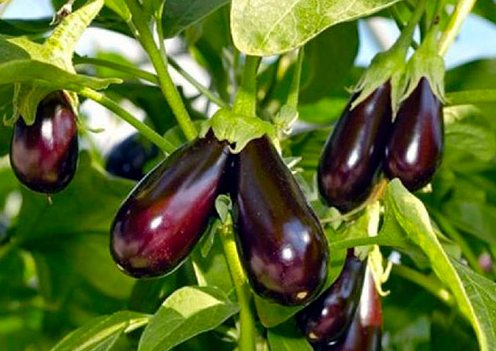

Super productive variety Balagur
When growing white eggplant, you should pay attention to early maturing varieties and hybrids. These varieties are resistant to adverse conditions and yield good yields. Despite the fact that eggplants are thermophilic and capricious, mid-season varieties of snow-white fruits, Swan, Taste of mushrooms and an egg-shaped bright yellow Dutch variety Golden Eggs, were bred for open ground.
For greenhouses and film greenhouses, the varieties Gorodovoy F1, Airship, Emerald are suitable.
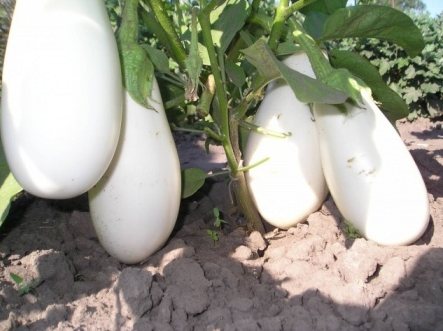

Bibo white eggplants
Eggplants, even the earliest varieties, have a much longer growing season than, say, peppers and tomatoes, so we sow them for seedlings earlier.
- early ripening varieties - 100 - 130 days to full ripeness;
- late varieties - 130 - 180 days, to full ripeness.
Based on these indicators, we draw conclusions if we want to get an eggplant crop already at the end of July - in the first decade of July, it is better to sow seeds for seedlings in the second half of January - February. You can read more about growing eggplant seedlings in our article.
Video - The best varieties of eggplant
The choice of the variety.
Thanks to the labors of breeders, a huge number of varieties and hybrids have appeared.The choice of a variety must be approached on the basis of the following principles:
- Where the cultivation will take place. In a greenhouse, greenhouse or open field.
- In the region with what climate do you live.
- When you are going to plant seedlings.
The southern regions are more fortunate. You can go to the store and feel free to buy any variety. In regions with a temperate climate, preference should be given to mid-season and early-season ones. Below we provide a small selection of proven and popular varieties.
Cornucopia.
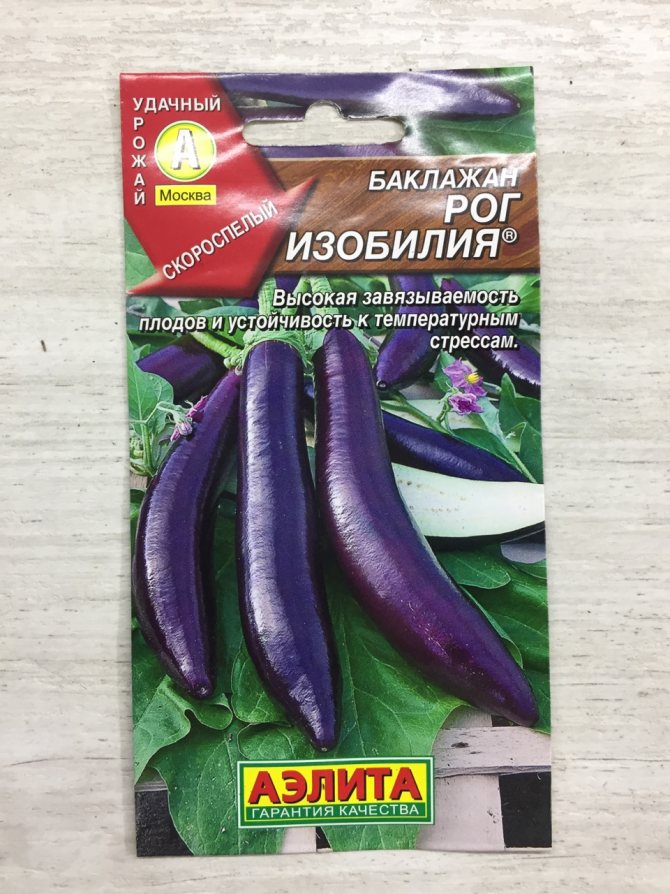

Cornucopia variety
Mid-season variety with high yield. Fruiting begins 120-130 days after germination. The fruits have a very small amount of seeds, so they are very convenient to use in cooking. Suitable for greenhouse and outdoor cultivation.
- Plant height - 150-200 cm.
- The shape of the fruit is very similar to a horn, has an elongated shape.
- The color is dark lilac.
- Fruit weight - 150-200 gr.
Alekseevsky.
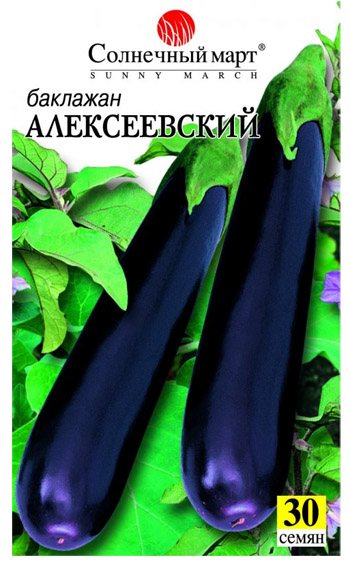

An early ripe variety with a high yield. From the moment of germination to the beginning of fruiting, 110-135 days pass. The variety is intended for cultivation in a greenhouse, but in the southern regions it can be grown outdoors.
- Plant height - 60-70 cm.
- The fruit is cylindrical.
- The color is dark lilac.
- Fruit weight - 100-190 gr.
Banana.


Popular early maturing variety. From germination to receiving the first fruits, it takes 90-110 days. Sor "Banana" can be grown both in the greenhouse and in the open field.
- The plant is compact, 40-50 cm high.
- The fruits are smooth, cylindrical in shape.
- The color is dark lilac.
- Fruit weight - 150-160 gr.
Valentine F1.
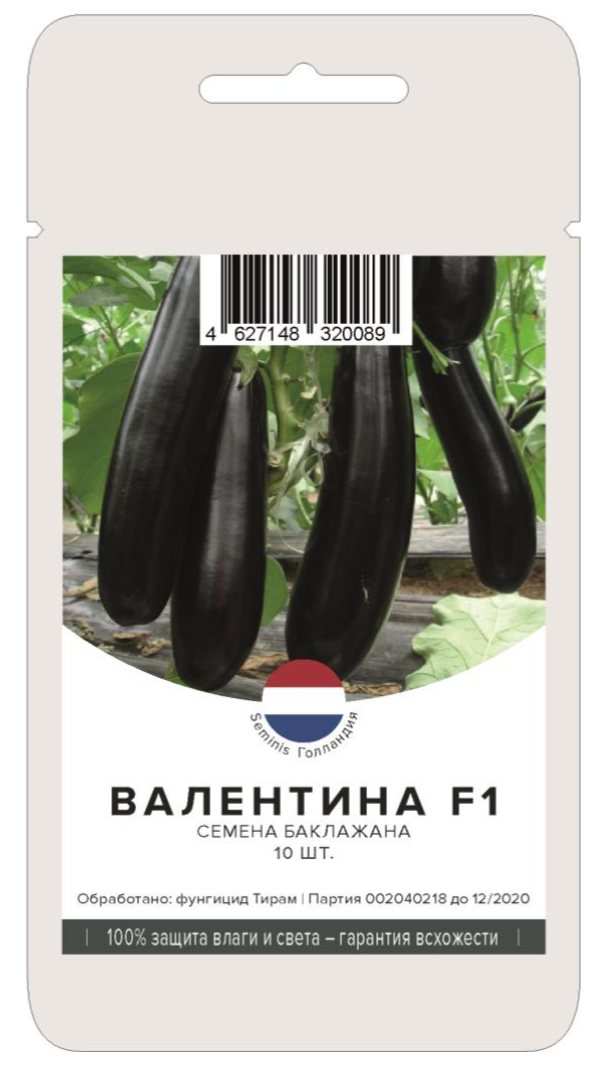

Hybrid Valentine F1 is intended for growing in a greenhouse or under a film shelter. However, in the southern regions, you can get a good harvest in the open field.
- Plant height - 80-90 cm.
- Fruits are elongated, drop-shaped.
- The color is dark purple.
- The fruits are large, weighing 200-250 grams.
Bourgeois F1.
Bourgeois F1 is an early ripe hybrid. Suitable for outdoor cultivation. Resistant to cold weather conditions and easy to maintain.
- Plant height - up to 170 cm.
- The fruits are flattened.
- Very dark fruit color.
- Weight - 120-150 gr.
Possible problems with eggplant seedlings and their solution
Not everyone succeeds in growing high-quality and strong seedlings from the first time, numerous problems are possible, ranging from yellowed leaves to the invasion of aphids. And experienced gardeners who know all the rules for caring for eggplants periodically encounter these troubles. There is no need to be afraid, most problems have a simple solution.
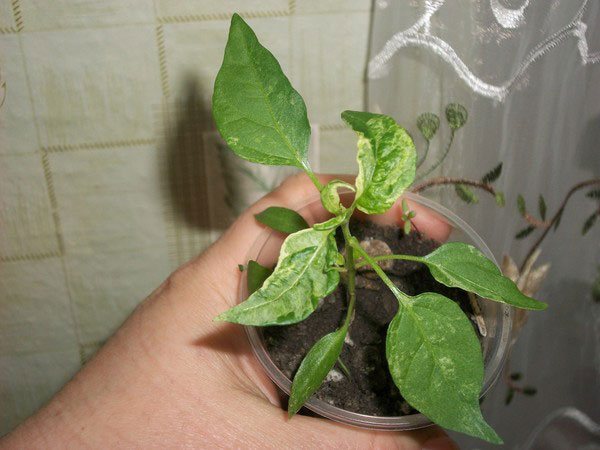

Seedling diseases
Stopping growth - what to do ↑
One of the most common troubles that novice summer residents face is stopping the growth of young seedlings. What could be the cause of this problem, because at first the plants grew right before our eyes? Slowdown and even complete cessation of growth indicates a problem with the roots of the plant.
There are several factors that can affect the growth of seedlings:
- not enough free space for the root system;
- damage to the roots;
- insufficiently fertile soil.
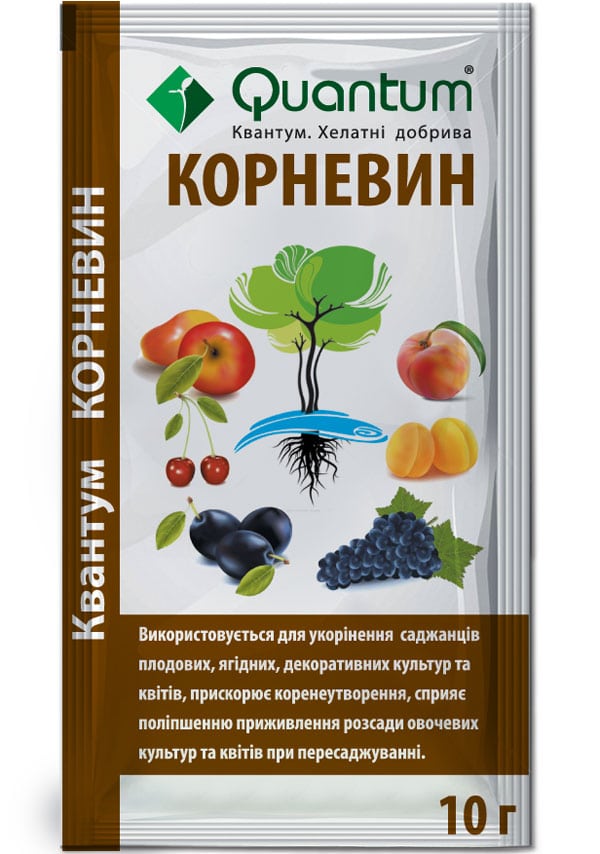

Root dressing
To speed up the growth of your eggplant seedlings, you need to make sure there is enough room for the sprout in the pot. It is not difficult to check this: gently pry up and try to get one of the seedlings out of the pot. Pay attention to the roots: if they are brown, then the problem is in the wrong pot. If the transplant is done on time, growth should resume.
If the stop occurred immediately after your intervention (diving, transshipment, landing in the ground), most likely, root damage has occurred. Growth has stopped because the plant needs to gain strength and, first of all, restore the roots. You can help him in this and speed up recovery with the help of special preparations that are introduced into the soil (Kornevin, for example).
Leaves wither - solutions ↑
Another problem is fading leaves.Normally, they should be firm and juicy, but there are a number of reasons that can turn young seedlings into wilting, stunted sprouts. If this happened to your "wards", do not panic, because in most cases, eggplant seedlings can be restored and strengthened. Causes of wilting:
- the roots lack air;
- low temperature;
- waterlogging.
The eggplant should be planted in light, loose soil. With poor drainage, excessive watering, or too close placement of seedlings, situations may arise when the root system does not have enough air for full life. What can be done:
- plant your plants in separate containers;
- clean the drain holes if they are clogged;
- loosen the topsoil without damaging the roots.
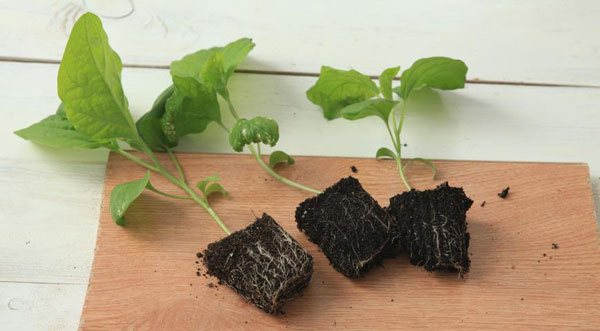

Leaves shrink and wither
If the southern eggplant is frozen, it will most likely start to wilt. Try to avoid hypothermia of a capricious vegetable. If you are carried away by hardening the seedlings, and then it wilted, watering with warm water can save it. The leaves will return to their shape.
There are often situations when the temperature is acceptable, but the plant still withers. This happens when placing pots on a windowsill. When the temperature in the room is about 19-20 degrees, but cold air is blowing from the cracks in the frames, the pot, earth and roots are cooled, and the result is on the face, more precisely, on the leaves. Raise your pots 20 cm higher and the cold air will not harm your plants.
When the soil is waterlogged in pots, eggplant leaves can also wither. To prevent this from happening, do not overdo it with watering. And if the overflow is already taking place, and the ground is rotten and smells bad, transplant your bushes into new boxes and dilute the wet soil with fresh dry one.
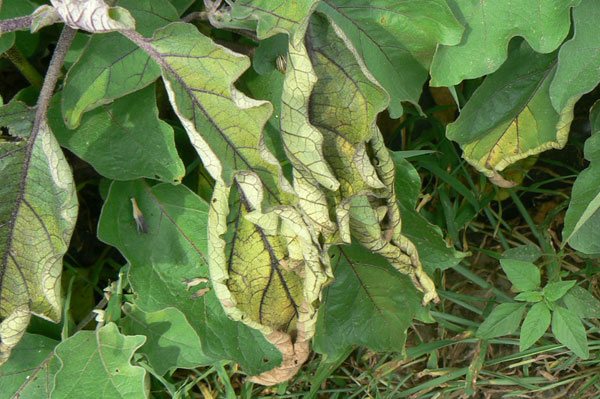

Photo of yellowing leaves
There are spots on the leaves - what to do ↑
This problem is very common, and there can be many reasons for it. If stains appear on the leaves, make sure they are not too close to the backlight. Direct rays of ultraviolet radiation can cause spots on the leaves.
If the lower leaves of the seedlings dry and crumble, the reason lies in the lack of nutrients in the soil. Indulge your plants with fertilizers. However, do not overdo it, an overabundance of potassium also leads to deformation and drying of the leaves.
If you find damage on the leaves in the form of holes in the middle of the leaf, then the work of pests is in front of you. To reanimate eggplant seedlings, inspect the affected bush, sometimes you have to use a magnifying glass. Identify the pest and treat the eggplant with appropriate chemicals. If one bush in ten is affected, you can try alternative methods, but if all the seedlings are affected, it is better not to risk it and resort to chemicals.
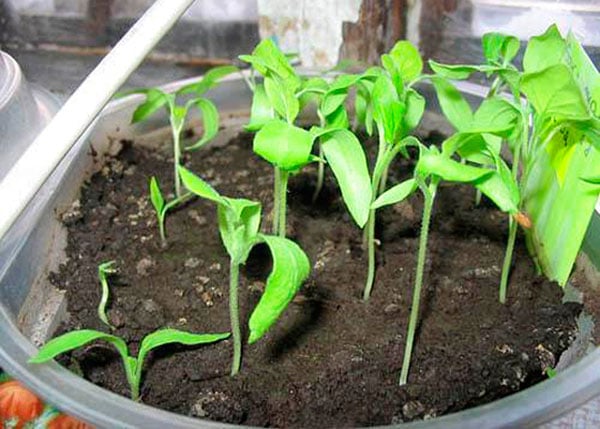

The stalks are stretched out
How to prevent pulling ↑
If the eggplant seedlings are stretched out, the sprouts have become thin and weak, you need to look for the cause of the problem and take action. Most often this happens with improper care of light and heat-loving plants. The reason may be a lack of light, which most often happens. Highlight the seedlings or increase the duration of the supplementary lighting.
The stems can also lengthen with excessive watering. The answer is obvious - moderate your ardor and water the seedlings without fanaticism. Low temperature of water and air during cultivation is another reason for stretching. Follow the recommendations for the optimal temperature regime, and the problem will not affect you.
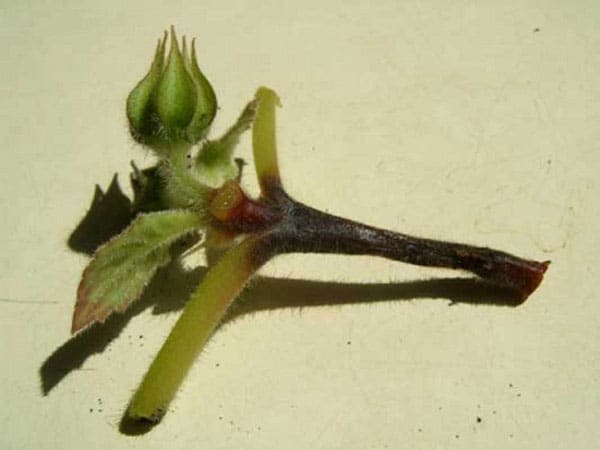

Black leg seedlings
Enemy of seedlings - black leg ↑
The most common disease that affects immature stems is the black leg. Here the name speaks for itself. It is not difficult to diagnose this disease - the lower part of the stem - the leg - turns black, bends, then the plant begins to wither and eventually dies.
It will not be possible to cure the black leg, but if you notice its manifestations on several seedlings, remove the affected specimens immediately so that the disease does not spread to the rest. The soil in the tray can be sprinkled with ash - a natural antiseptic, and healthy sprouts can be treated with protective solutions.
By and large, growing eggplant seedlings is not so difficult even at home. Preparing, sowing and tending is very similar to growing tomatoes or lettuce. If you follow the recommendations and do not neglect the advice of experienced summer residents, in the summer you can harvest an excellent harvest of blue ones.
We start sowing seeds
Eggplant seedlings can be grown with or without diving. Without picking, the roots of the culture will easily tolerate the transplanting process, so this method is preferable.
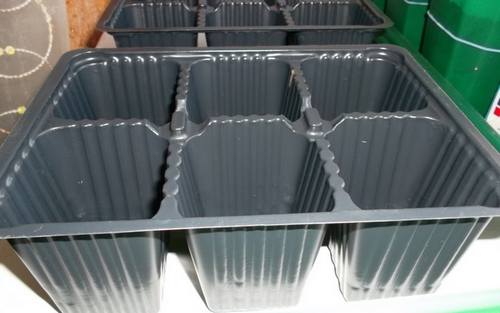

The choice of container for planting should also be approached responsibly. It is best to give preference to plastic containers, peat tablets or peat composts. If you take plastic cups, then before direct planting they should be disinfected and passed with a weak solution of potassium permanganate.
Sowing dates for eggplant seedlings are calculated taking into account the optimal calendar days and variety. A couple of weeks before sowing, it is worth checking the seeds for germination.
This procedure should be carried out as follows:


you need to soak the seeds in water and leave for 24 hours. Then take them out and spread them out on a gauze pad and leave in a warm place, regularly moistening the cloth.
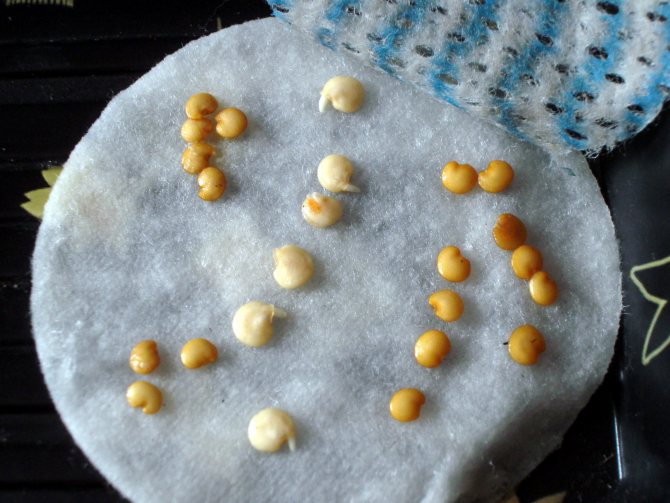

If after 1 week half of the seeds have sprouted, then we can talk about high-quality seed and start planting it in a container.
Preparatory stage. What to do with the seeds?
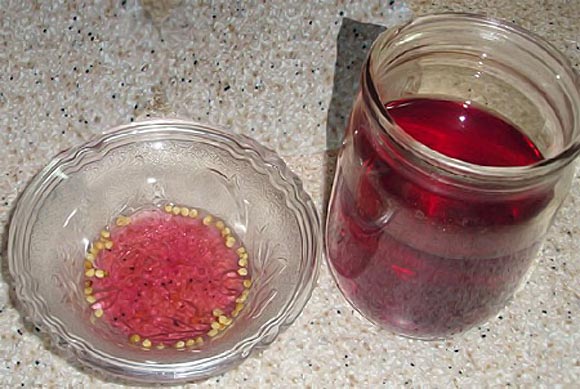

The process of planting eggplant for seedlings begins with the disinfection of the seeds. To do this, you can place them in a solution of potassium permanganate, always strong, or in a solution of water with hydrogen peroxide (3 ml of the drug per 100 ml of water).
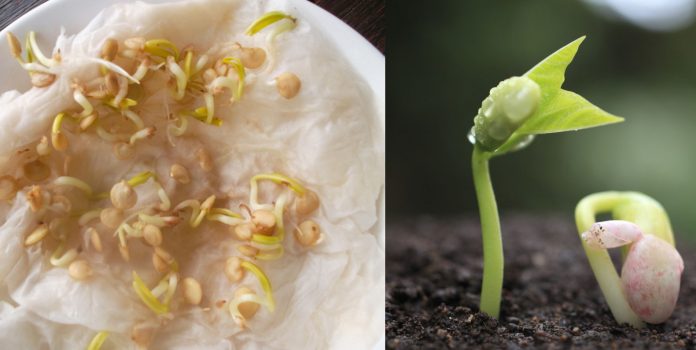

After the disinfection procedure has been completed, you can proceed with their rinsing and stratification procedure. All seeds are laid out in an interlayer of cloth soaked in water, sent to a container and placed in the refrigerator overnight. In the daytime, the seeds in the container are taken out and stored under room conditions. After one week, they should be soaked in warm rain or melt water with diluted growth stimulants.
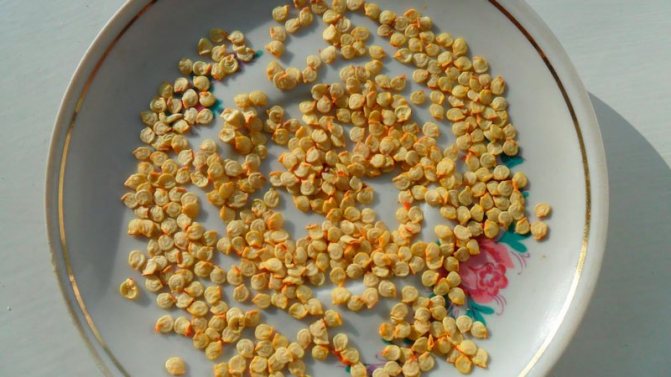

After - the seeds are dried on a regular sheet of paper. Now you can start disembarking them.
Stage two - we sow
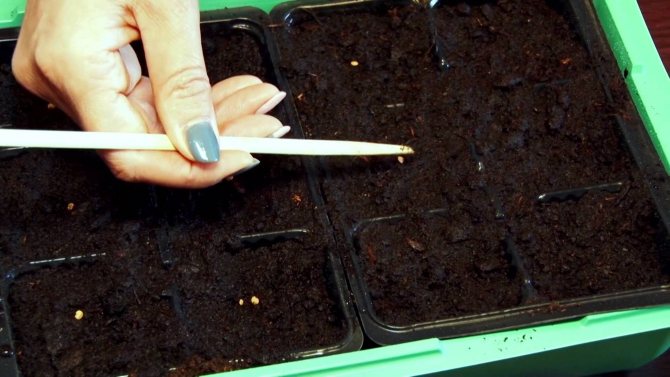

Having decided on the date according to the calendar, you can proceed to the process itself. We take the prepared seeds and put a few things in prepared containers. Planting eggplant for seedlings should not exceed a depth of 2 centimeters.
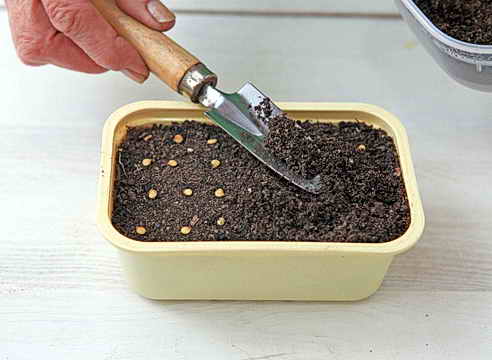

After, the seeds should be covered with soil, but in no case should it be tamped.
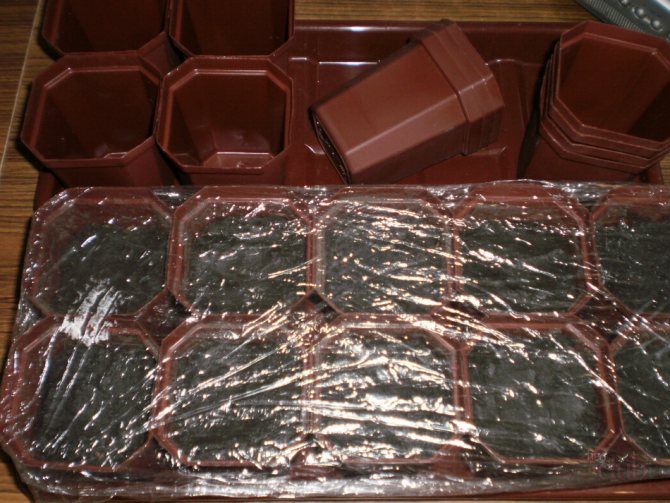

The containers must be covered with film or glass on top and kept until shoots appear at temperatures up to 30 degrees.
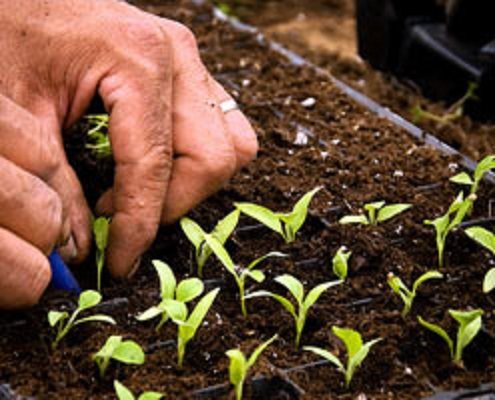

If you are an adherent of diving, then the seeds are sown in one large prepared container, which is filled with special soil. Here it is necessary to make shallow grooves for the seeds at a distance of about 6 cm. At a distance of 2 cm, lay out the eggplant seeds, close the grooves and also cover on top until shoots appear.
Special conditions
Seedling eggplant, growing at home, requires special care and approach. She needs to create special conditions in order to please her later with her yield. As for the temperature regime, it is worth considering that the seeds themselves germinate from 23 to 28 degrees.
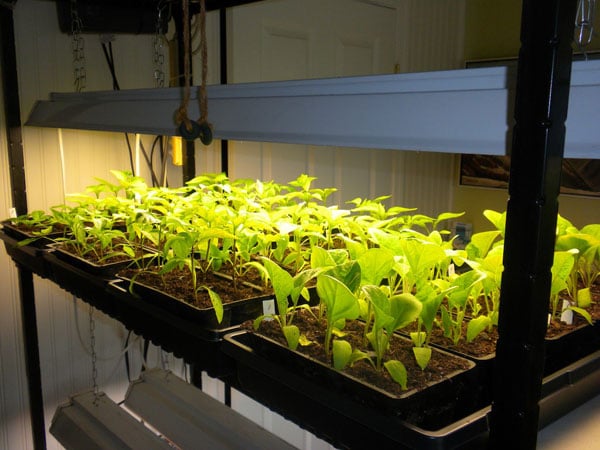

Speaking about lighting, it is worth considering that this culture is photophilous. Due to the presence of insufficient lighting or dense planting next to each other, eggplant seedlings will further please with small fruits. Therefore, the plants must be under light all day.It is recommended to turn the seedlings in the opposite direction every few days so that they do not stretch out and be thin.
Another important aspect when planting eggplant seedlings is indoor air humidity. This culture does not tolerate high humidity, so it is worth achieving good ventilation and humidity up to 70 percent.
Stage three - we take care of the seedlings
Adhering to the sowing dates for seedlings in a week, you will receive the first shoots. And here it is worth considering the special conditions for their care.
Seedlings of pepper and eggplant planting dates are practically the same, but eggplants require more moisture consumption. This feature is associated with the fact that they have larger leaves, which means that the process of moisture loss from the plant occurs several times faster.
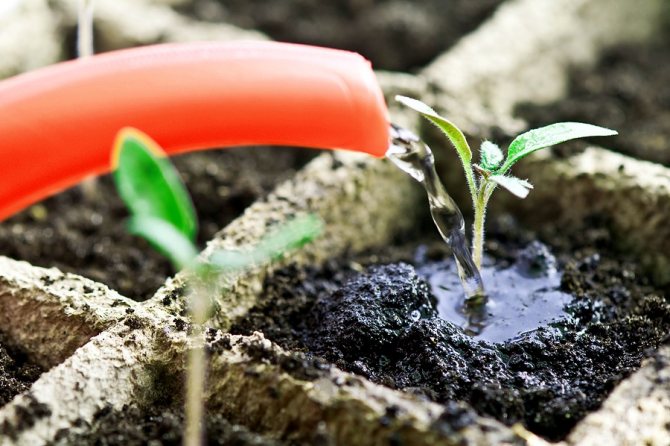

Seedlings should be watered once a day with settled water at a temperature of 25 degrees. Further, the watering process occurs as the top layer of the soil dries up, while it is worth not allowing overflow.
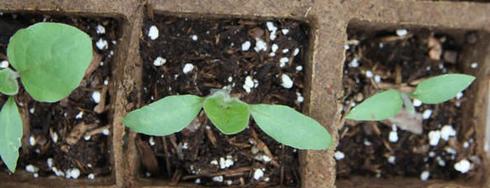

Growing eggplant seedlings at home should be fed regularly. If the amount of nitrogen is insufficient, the development of the culture may slow down. It is worth feeding the seedlings from the moment of their germination to the formation of a woody stem.
To ensure high bud formation and a good root system, it is worth adding phosphorus. To give a pronounced taste to the fruits of eggplant and increase its resistance to various diseases, it is worth feeding with potassium. Seedlings of eggplant in order to have a developed root system that feeds the whole plant needs magnesium. Therefore, one cannot but underestimate the significant contribution of bait to the growth and productivity of the plant.
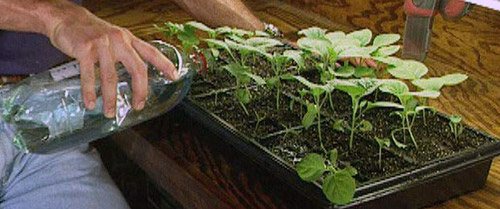

As an increase in immunity and resistance to the development of diseases, you can use a spray of Epin or Zircon solution every week.
The process of diving seedlings (for those who planted seeds in one large container) should occur when the plant has already developed 2 true leaves.
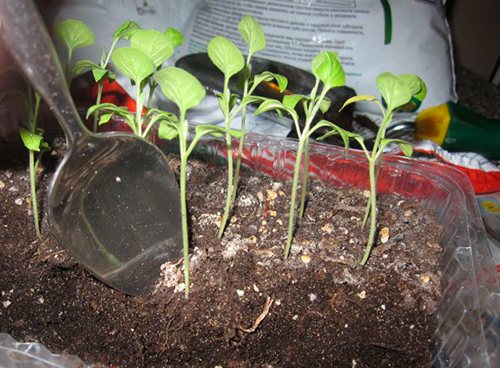

Then it is worth preparing new containers and filling them with special soil. Home-grown eggplant seedlings require careful handling during the pick. The destruction of the earthen coma formed near the root system is not allowed.
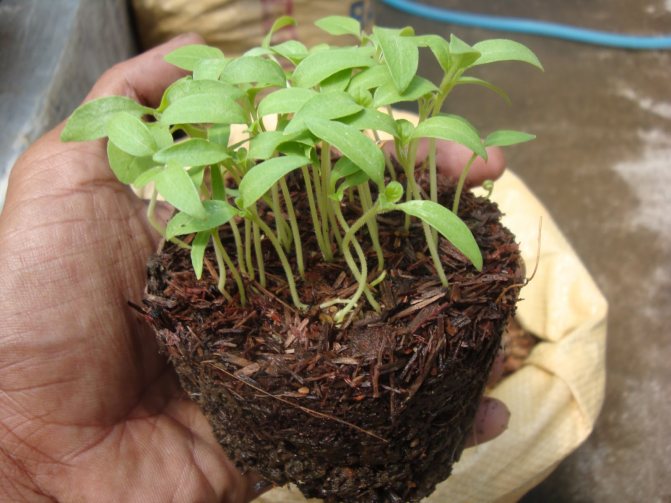

It should be planted in a new container along the edge of the cotyledon leaves in small, pre-prepared grooves. Watering eggplant seedlings after diving can be done no earlier than 6 days later. It is also best to keep the seedlings out of direct sunlight to avoid damaging them.
After diving, the growth process may slow down for a short time, but this is considered a completely normal reaction of the culture to the procedure.
Picking
Seedlings dive after the regrowth of 2-3 true leaves, this is about a month after the emergence of shoots. Plants are planted one at a time in separate pots and cups. Each must be carefully removed from the box along with a damp clod of earth, without disturbing the root system. You cannot pinch the roots of eggplants, they then recover for a long time. When transplanting, the best seedlings are selected, weak and crooked ones are discarded. After transplanting, the seedlings are watered. Within 3-5 days after transplanting, the plants are shaded, avoiding prolonged exposure to direct sun.
Video on how and when to sow eggplants for seedlings
Since this type of vegetable has a long growing season, you should buy seeds with a fruit ripening period of no more than 120 days. The height of the bush and the size of the fruit should be taken into account. In order to have time to get the harvest, it is better to grow plants with an average fruit size.
One of the important issues that must be resolved before planting is to determine the date of planting seeds in the ground, taking into account the Lunar calendar. You should take into account not only the dates given in the calendar, but also the climatic conditions of your region, as well as the type of plant.
Good harvests to you, dear readers!
When the seeds have sprouted
When the first "loops" appear, the seedlings should be transferred to a cooler place:
- + 18-20 ° С during the day,
- +15 ° С at night.
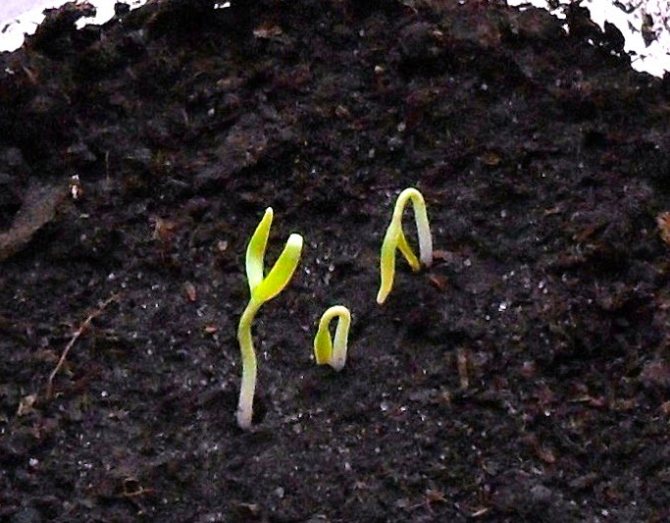

These conditions are well matched by a glazed loggia or a greenhouse, just make sure that the night temperature does not fall below the critical one. In this thermal regime, keep the eggplants for 4-5 days. This is a very important period. Do not be embarrassed by the fact that the sprouts “stand still” - the plant grows its root system.
What is eggplant
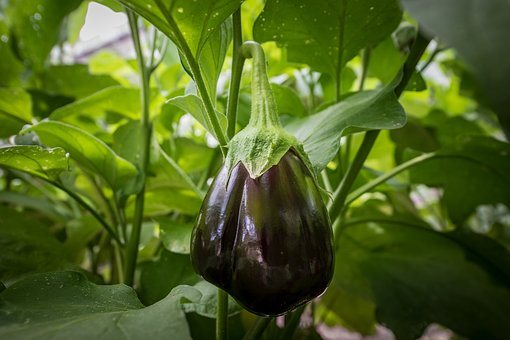

A low plant with a height of 40 to 150 cm. Foxes are large, green in color with a purple tint. Flowers with a diameter of 1.5-2.5 cm, purple. Inflorescences of 2-7 pieces. The fruit is large, cylindrical, round, up to 70 cm long and weighing up to 1 kg, dark purple in color.
The homeland of eggplant is India. The wild form of this vegetable is still growing there. He came to Europe in 327 BC during the Indian campaign of Alexander the Great. In the beginning, Europeans did not know how to grow an overseas vegetable. During cultivation, he accumulated toxic substances and there were cases of poisoning.
It was brought to Russia only in the 17th century. It is believed that Turkish merchants were the first to bring eggplants. Since then, the "blue" ones have diversified Russian cuisine.
Planting and caring for eggplants (briefly)
- Landing: cultivation is carried out exclusively through seedlings. Sowing is carried out in late February and early March. Landing in the ground - in late May - early June.
- Priming: Sandy loam soil with a high organic content is best.
- Lighting: bright light required.
- Watering: moderate, do not dry out the soil.
- Top dressing: it is recommended to do it more often. During the cultivation period in the open field, they are fed once every 2-3 weeks. First, they are fed with nitrogen fertilizers, and then they smoothly switch to potash.
- Reproduction: seed.
When and how is eggplant seedling picking carried out?
Picking is the transplanting of seedlings in a separate container for each root. In this case, in the case of eggplants, truncation of the main root is not necessary. These works are carried out when 2-4 true leaves are formed on the plants.
Eggplant pick:
- Water the seedlings in a common box, let the soil soak well, leaving the containers after watering for 2-3 hours.
- Prepare custom cups. Pour the soil mixture into them and moisten it.
- When digging each plant out of the common container, place it together with the root ball of earth in a pot. In this case, hold the seedling not by the leaves, but by the stem.
- Bring the plant down to the cotyledonous leaves. Compact the ground lightly.
You can water the transplanted eggplants 3-4 days after the pick. During this time, protect the plants from direct sun exposure so that they can adapt more easily. Provide the first three days with a temperature regime of 18-20 degrees.
More information about sowing eggplant for seedlings can be found in the following video:
Growing eggplant seedlings requires responsibility and dedication. With the correct sowing date, competently carried out preparation for sowing seeds, as well as with proper care, the seedling material will turn out to be strong and of high quality.
0
Preparation of soil mixture
If you want seedlings that will not only grow well in the future, but also please you with an excellent harvest, it is better to prepare the soil yourself. This will not take much time and effort, the composition of the ingredients, even for different mixtures, is quite simple:
Important! One “piece” can be anything: a cup, a bucket, a shovel. The main thing is to keep the proportions indicated in the recipe.
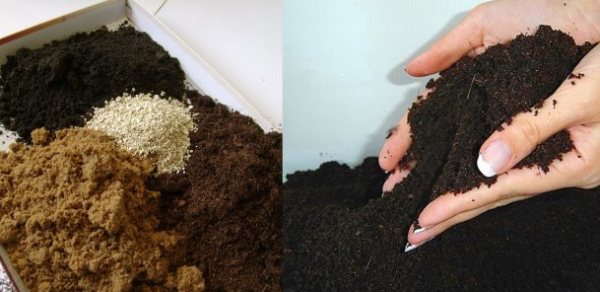

Eggplants prefer rich, light soils
The composition of the components can be changed, thereby facilitating or, on the contrary, supplementing it. The main thing to remember is that eggplant loves light, nutritious, slightly acidic or neutral soil, well-drained and fine-grained. Therefore, turf soil, sand, humus in a ratio of 1: 1: 2 + wood ash are also suitable for seedlings.
Important! Whichever composition of the mixture you choose, it is better to prepare it in advance - in the fall. Keep for freezing on a balcony, in a shed or on the street all winter, thereby disinfecting from pests and diseases.
Planting capacity
Eggplant is capricious and does not like transplanting, therefore, it is necessary to plant seeds immediately in the container from which it will subsequently be transplanted into the ground, without disturbing the roots. It can be a peat-humus pot, a cardboard or plastic cup with drainage holes, at least 6 cm in diameter.
If the area of the windowsill does not allow you to immediately plant in large pots, you can sow the seeds in peat or plastic mesh blocks (cassettes), or peat tablets.
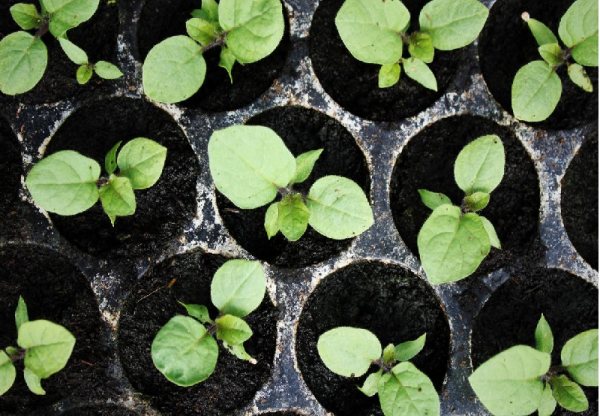

Due to limited space, seedlings in cassettes do not outgrow
Important! So that the seedlings do not shade each other, with a small size of cassettes, just plant them in a checkerboard pattern.
Whatever seedling container you choose, it should have the following features:
- environmentally friendly raw materials for manufacturing, without toxic substances and pathogens;
- the material of the container should provide an optimal water-air regime, without stagnation of water and nutrients, which lead to decay and death of the plant;
- easy extraction of the plant for transplanting, so as not to injure the roots.
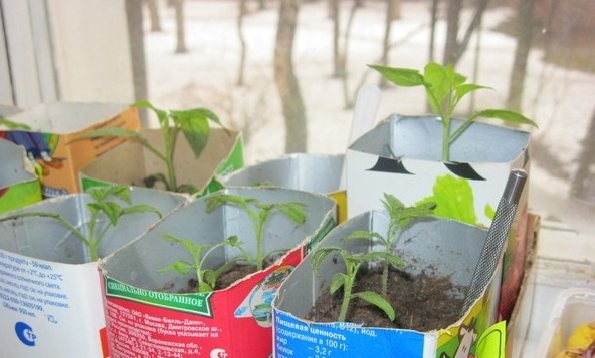

Classic seedling containers - milk bags.
Ready cups or cassettes should be filled with soil mixture and placed in trays, watered, now they are ready for sowing.
Soil for eggplant
Soil for eggplant should be light and fertile with neutral or weak acidity. Its optimum level is 6.0-6.7 pH. Soil manufacturers offer a variety of ready-mix options. For seedlings, experts do not advise using soils consisting of one peat. It is better to prepare the land for sowing yourself.
For a universal seedling soil, 4 components are needed: 2 parts of garden soil and one part of humus (compost), peat and sand. A little ash is added to the mixture to reduce the acidity of the peat. Additionally, a complex mineral fertilizer is introduced into the soil - 50-80 g per bucket of soil.
When to sow seeds?
In order not to be mistaken with the timing of sowing seeds, you must first of all be guided by the weather conditions of the region in which you live, namely at the time of the last frost. And although there is no universal formula, for eggplants it is 10-12 weeks before the last frost.
We plant seedlings in the ground when the ground has warmed up stably to +18 C and does not drop below +15 C, and the air to +20 C. If the soil temperature is below these parameters, the growth of the plant will noticeably slow down.
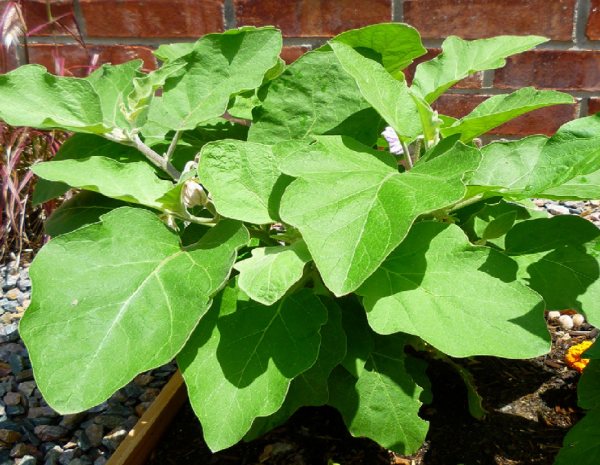

Eggplant loves warmth and does not tolerate a drop in temperature.
In addition to weather conditions, a number of other factors must be taken into account:
- The duration of the growing season. In northern latitudes, where the growing season is short, it is important to use early maturing eggplant varieties. In addition, you can focus on the average data, eggplants have a growing season of 100-180 days. For this reason, late varieties are sown in January – February, and early varieties in March – April.
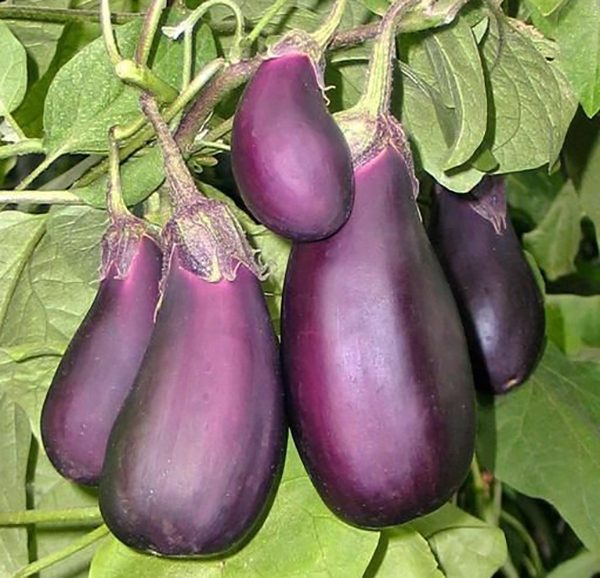

Early ripe eggplant variety
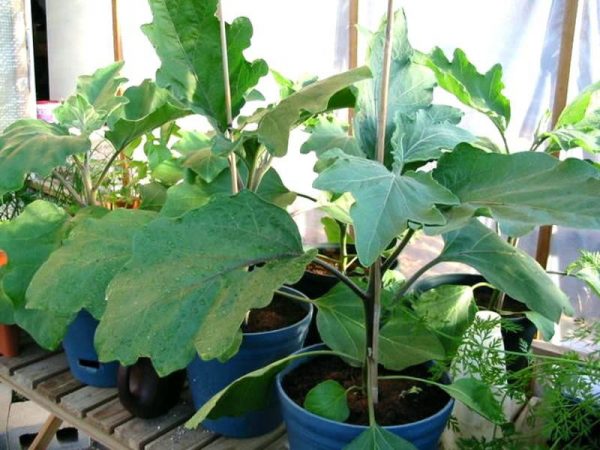

Overgrown eggplant seedlings
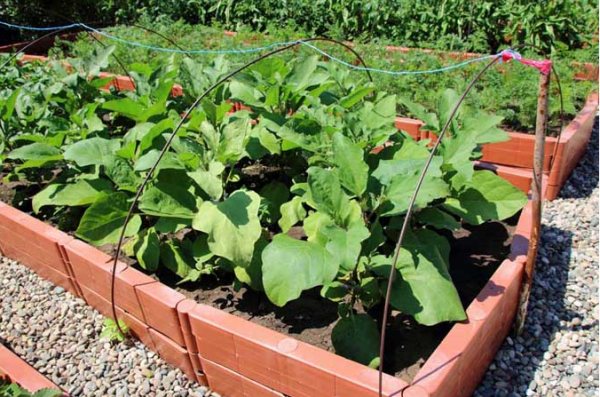

The soil in greenhouses should have high humidity and not dry out
- pre-sowing treatment with preparations accelerates seed germination;
- purchased seeds, unlike seeds of their own collection, do not need preliminary awakening from storage;
- seedlings from dry seeds appear much later than from pre-soaked ones;
- stratification accelerates the process of seed germination.
If you focus on the average seed germination rates, then for eggplants it is 8 - 10 days.
Possible reasons for eggplant not sprouting
There are several reasons why the sown seeds do not germinate, but you need to worry not earlier than two weeks after sowing the prepared seeds. The reasons can be both in the seeds and in the conditions in which they got.
- Unsuitable seeds: the shelf life of eggplant seeds is several years, so it is advised to check them for germination before sowing.
- Use of seeds treated by the manufacturer: some modern seed preparation technologies increase yields, but delay seed germination; we have to wait a little longer.
- Planting seeds too deep: 2–3 cm is not a problem, and with deeper sowing, soaked seeds can rot.
- There is not enough heat: at temperatures below 20 ° C, the seeds may "think" for a very long time, or even not sprout at all.
- Unsuitable soil moisture: in overdried soil, the seeds could dry out, and in swampy soil, they could suffocate and rot.
Which is better - sowing or germinating eggplant?
The seed germination time depends on several factors. This can be greatly influenced by the year in which the seeds are harvested and put aside for storage. Despite the fact that eggplant seeds can be stored for up to 8 years, their best shelf life is a maximum of two years. In the future, their performance is noticeably reduced.
Before sowing, many ask the question: to germinate seeds or to plant them in the soil right away?
Without germination, seedlings can be waited for at least 20 - 25 days. But mostly more. Therefore, in order to significantly shorten this period, the seeds are best germinated in advance. And only then spread into the ground.
Germination time also depends on several factors:
- temperature regime;
- humidity;
- lighting mode;
- prepared soil for planting.
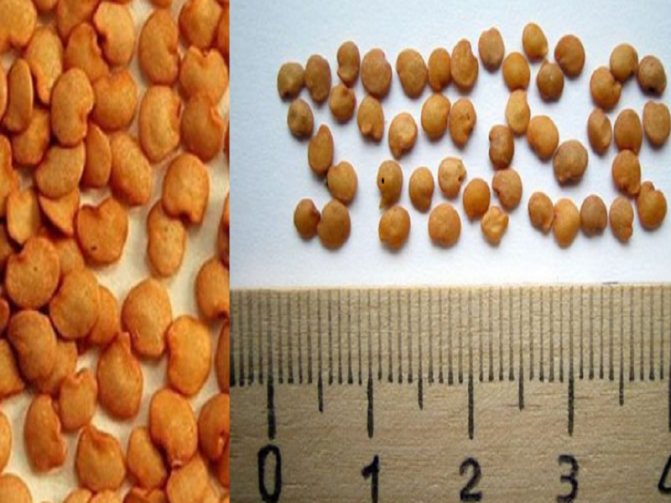

Before germinating seeds, they must be checked for suitability. Be sure to iterate over them. Divide them into several piles by size: large, medium and small. More experienced summer residents will tell you that the selected seeds by size and planted in the ground of the same size will give the best germination and yield.
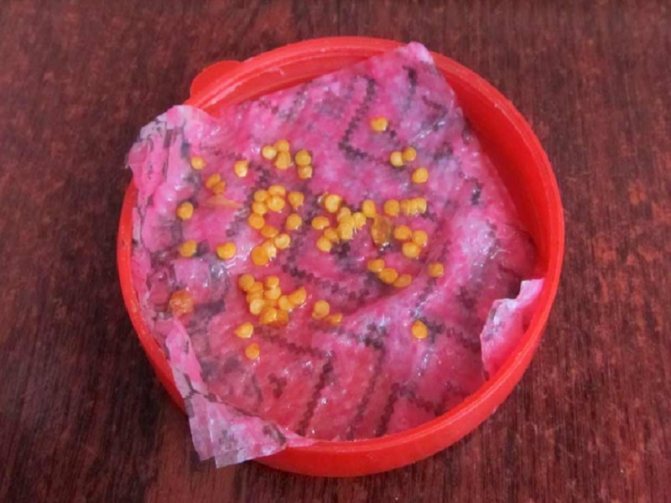

You can test the seeds for suitability as follows: pour a small amount of water at room temperature into a glass. Dissolve a tablespoon of salt in it. Pour seeds into it.Those that float within 12 hours are considered unusable.
Let's consider the most common method of germination. Place a small piece of gauze or cotton on a flat dish. Cotton fabric can also be used. Many people use regular paper napkins. Place the seeds on the prepared material. Drizzle with enough water so that the cloth or napkin is slightly hidden in the liquid.
Place a plate of seeds in a warm place. As soon as the water disappears, add it again. Repeat the procedure until sprouts appear.
To speed up the process, you can add a few drops of undiluted fresh aloe juice to the water before pouring it on the seed.
Features of care after sowing before germination
Without proper care of crops, getting healthy, strong seedlings is impossible. Compliance with the landing rules is only half the battle. Now create the necessary conditions for the growth and formation of seedlings.
Lighting
Seeds need light even before they germinate. Adequate illumination helps seedlings to appear sooner and more friendly. Daylight hours for eggplants should be at least 12 hours long. Therefore, in cloudy weather, use additional light sources (phytolamps, fluorescent lamps, etc.).
Temperature
For germination of eggplant seeds, a temperature of 21 to 26 ° C is required. After the emergence of continuous shoots, reduce the temperature regime to 16 ° C for 5-7 days to stop the growth of the stem, but activate the development of the root system. Further optimum temperature for seedlings is 23-25 ° C.
Humidity
Eggplants are capricious about fluctuations in air humidity. Growing seedlings requires maintaining this indicator at the level of 60-80%. To humidify the air, use special devices or place containers with water next to the seedlings. A wet cloth hanging on radiators increases the humidity in the room well.
Drying out or waterlogging of the soil must not be allowed. It should be constantly moderately moisturized.
What containers to use
Eggplants grow contentedly and take up "living space". And the "blue" ones do not tolerate the pick very well. Therefore, the container must be voluminous.
- Plastic disposable cups. This is one of the best options. They are very inexpensive. Moreover, they are voluminous and very comfortable. Just before use, be sure to make a drainage hole at the bottom.
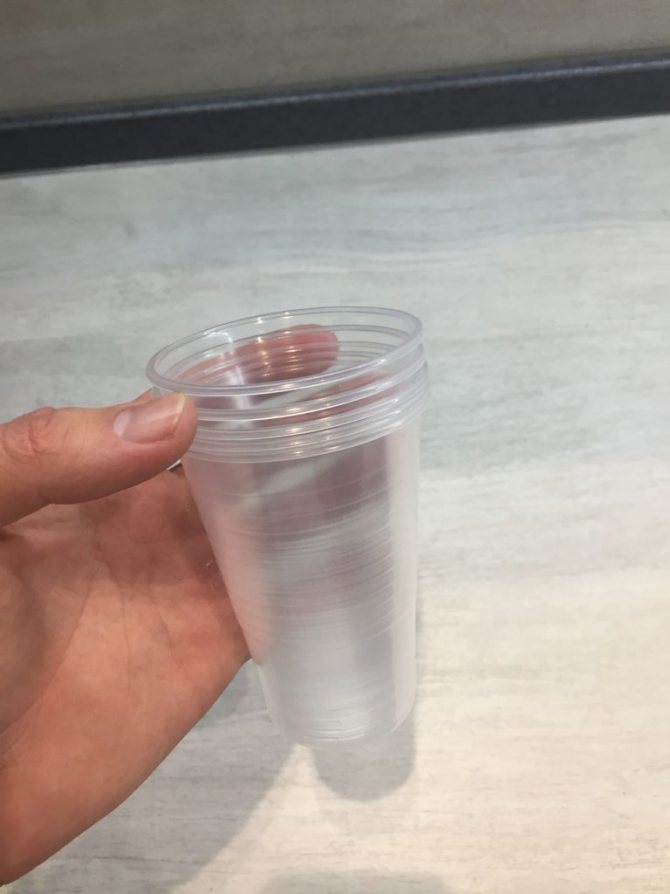

- Plastic cassettes for seedlings. The store has a very large selection of all kinds of containers. Plastic cassettes are great for eggplant. They consist of several cells. No prior preparation is required.
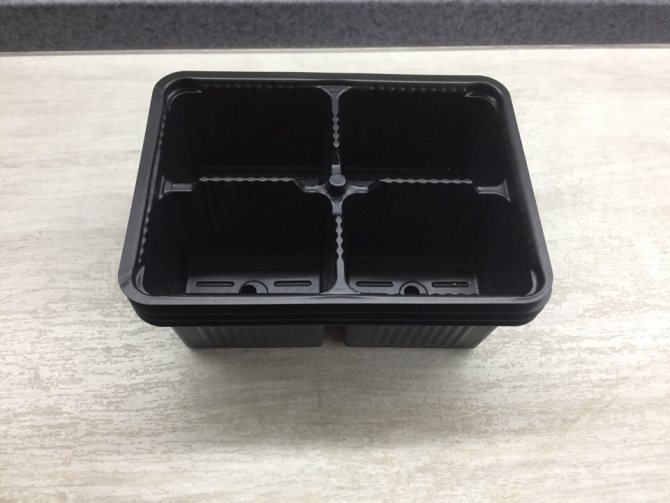

- Peat tablets. Recently, it has become very popular to sow seeds in peat tablets. It is very convenient. No additional preparation is required, no primer is needed. A high-quality peat tablet already contains the necessary composition for plant growth. In fact, they are compressed peat covered with a special fabric. Planting eggplant in peat tablets frees you from picking. The only negative is that you need to constantly monitor the humidity and prevent it from drying out.
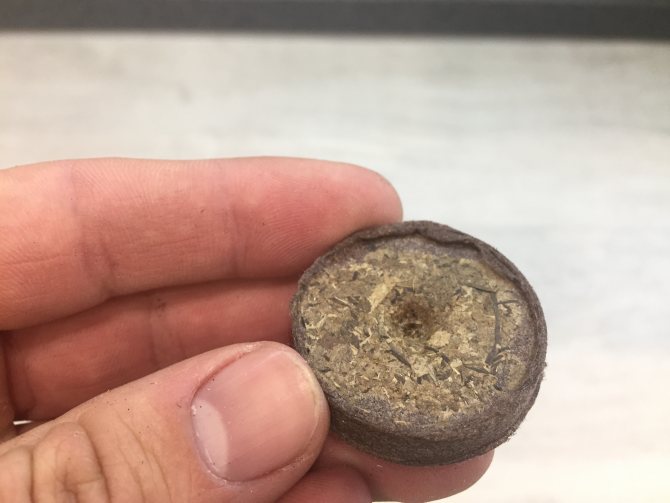

- Peat cups. In their shape, these are ordinary cups, only made of peat. The use of such a container is due to its ease of use. You can plant in the ground together with a glass, the roots will germinate through it.


- Large boxes. You can plant eggplants in bulky wood or plastic boxes. You can also use containers for home flowers.










